Quanta Computer WF1H Notebook PC User Manual User Menu P 4 warning 1
Quanta Computer Inc Notebook PC User Menu P 4 warning 1
Contents
- 1. Manual Part 1
- 2. Manual Part 2
Manual Part 1
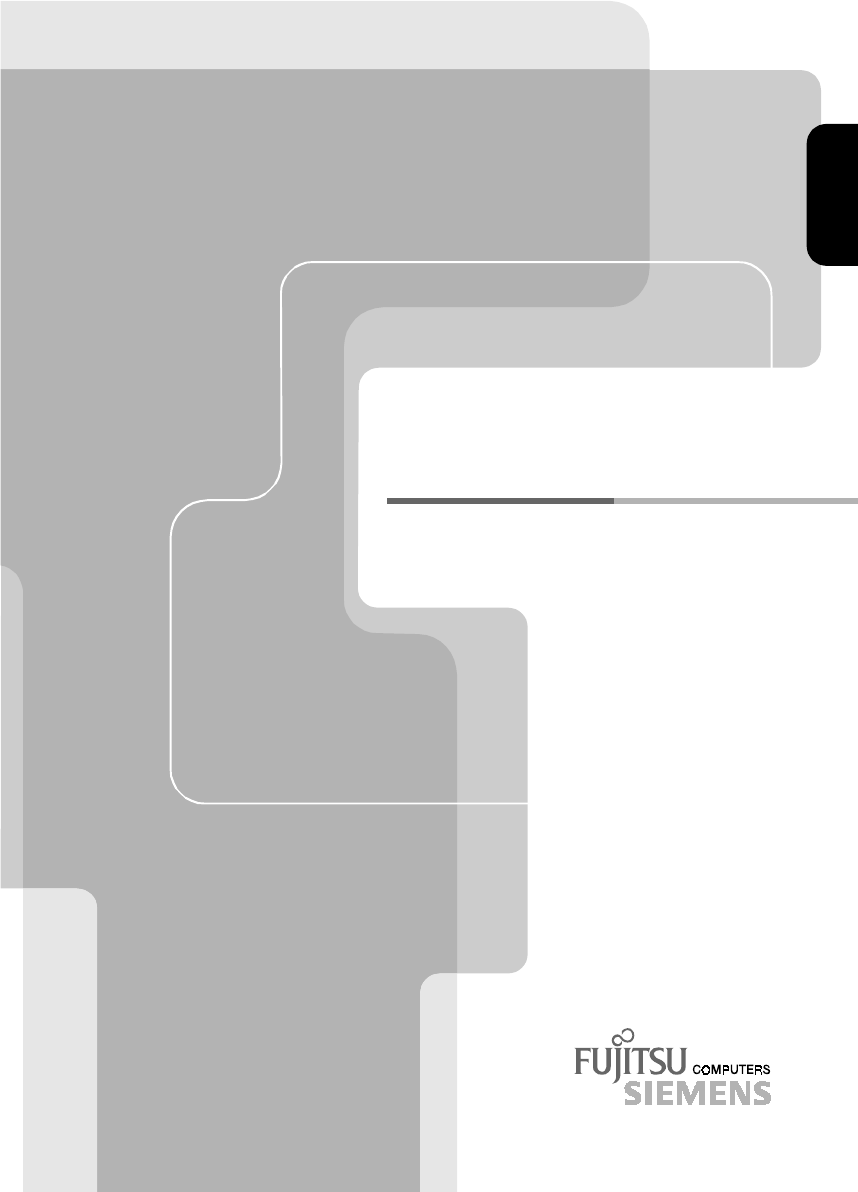
CELSIUS Mobile H
EasyGuide
Are there ...
... any technical problems or other questions you need clarified?
Please contact:
• your sales partner
• your sales outlet
You will find further information in the "Safety, Warranty and Ergonomics" booklet.
The latest information on our products, tips, updates, etc., can be found on the Internet under:
http://www.fujitsu-siemens.com

Dieses Handbuch wurde auf Recycling-Papier gedruckt.
This manual has been printed on recycled paper.
Ce manuel est imprimé sur du papier recyclé.
Este manual ha sido impreso sobre papel reciclado.
Questo manuale è stato stampato su carta da riciclaggio.
Denna handbok är tryckt på recyclingpapper.
Dit handboek werd op recycling-papier gedrukt.
Herausgegeben von/Published by
Fujitsu Siemens Computers GmbH
Bestell-Nr./Order No.: A26391-Kyyy-Z120-1-19
Printed in the Federal Republic of Germany
AG 0601 06/01

CELSIUS Mobile H
Operating Manual
Introduction
Important notes
Preparing the notebook
for use
Working with your
notebook
Connecting external
devices
Settings in BIOS Setup
Troubleshooting and tips
Memory extension
Technical data
Index
June 2001 edition

DPMS and VESA are registered trademarks of Video Electronics Standards Association.
Intel is a registered trademark, Pentium and Celeron are trademarks of Intel Corporation, USA.
Microsoft, MS, MS-DOS, Windows, and Windows NT are registered trademarks of Microsoft
Corporation.
OS/2 and PS/2 are registered trademarks of International Business Machines, Inc.
Zip is a trademark of Iomega Corporation.
Macrovision is a trademark of Macrovision Corporation, USA.
All other trademarks referenced are trademarks or registered trademarks of their respective
owners, whose protected rights are acknowledged.
Copyright Fujitsu Siemens Computers GmbH 2001
All rights, including rights of translation, reproduction by printing, copying or similar methods, in
part or in whole, are reserved.
Offenders will be liable for damages.
All rights, including rights created by patent grant or registration of a utility model or design, are
reserved.
Delivery subject to availability. Right of technical modification reserved.

A26391-Kyyy-Z120-1-7619
Contents

A26391-Kyyy-Z120-1-7619 1
Introduction
Your CELSIUS Mobile A is a versatile and ergonomic notebook. Innovative technology and ergonomic
design make this notebook the ideal user-friendly and reliable travel companion.
To simplify the initial start-up of your notebook, one or two operating systems are preinstalled on the
hard disk (dual-installation). If two operating systems are preinstalled, you can select which of the two
operating systems you want to install during initial start-up.
The energy-saving processor and the energy-saving functions that can be configured allow you to
make the most effective use of the battery capacity.
Your notebook has 128 -1024 Mbyte of main memory installed, depending on the upgrade level. Data
is stored on a hard disk drive. Your notebook is also equipped with a 3 1/2-inch disk drive. Depending
on the model, your notebook is delivered with a CD-RW drive or a DVD-ROM drive. A PC card slot
(CardBus or PCMCIA) enables the notebook to operate two type I or type II PC cards or one type III
PC card. Depending on the variant, your notebook may be equipped with an internal mini-PCI board.
Your notebook has connectors for external devices such as an external monitor, a printer, and a
mouse. The ECP capable parallel port is designed for fast bidirectional data transfer. You can connect
peripheral devices such as a scanner, loudspeakers, gamepads, keyboard, or mouse via the two USB
ports. In addition, your notebook is equipped with a TV-Out connector to connect to a television.
For mouse control, the notebook has a touchpad with touchpad buttons.
An audio controller, two built in loudspeakers and a built in microphone provide your notebook with an
audio capability. You can thus incorporate voice, noise effects and music into your notebook
environment. You can also connect an external microphone and an external loudspeaker.
The system settings of the notebook can be configured via the user-friendly BIOS Setup programme.
Certain system settings (e.g. screen display, energy saving functions) can be modified via various key
combinations while you are using the notebook.
Your notebook has a number of security features to ensure that no unauthorised persons can access
your data. For example, you can activate a screen saver with password protection. The security
functions in the BIOS Setup also allow you to protect your data by means of passwords.
This Operating Manual tells you how to put your notebook into operation and how to operate it in daily
use.
Additional information on your notebook is contained in the following documents:
• in the manual „Safety and Ergonomics“
• in the manual "Getting Started"
• in the documentation of the operating system
• in the information files (e.g. *.TXT, *.DOC, *.WRI, *.HLP)
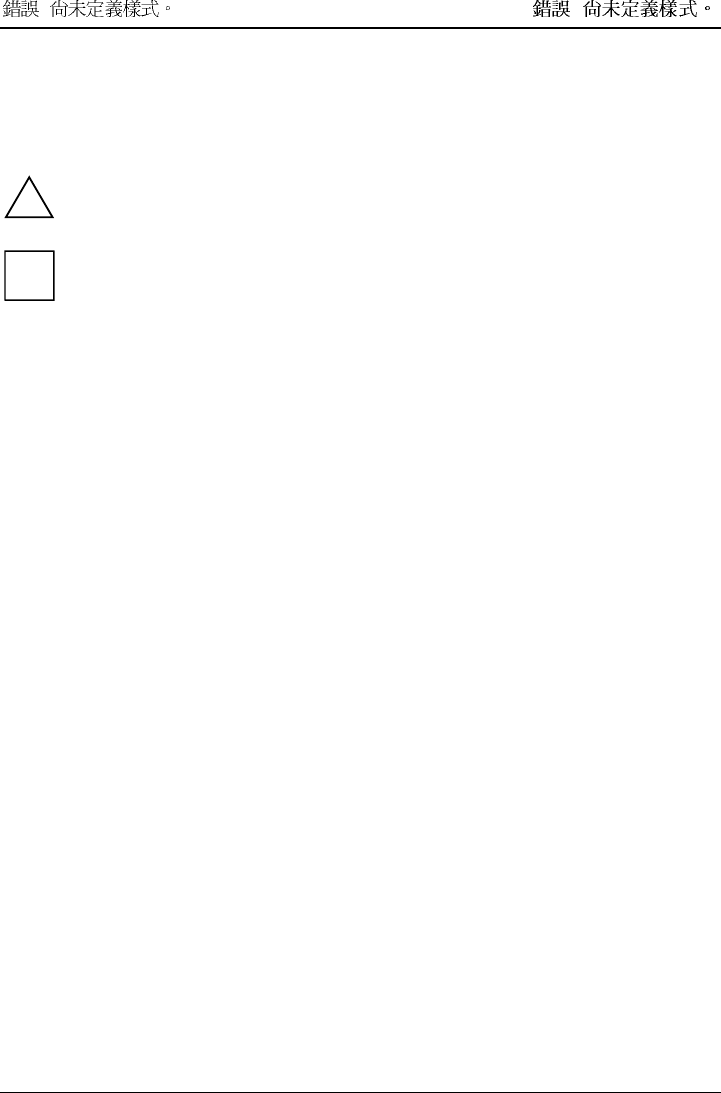
! !
2
Notational conventions
The following symbols are used in this manual:
!Indicates information which is important for your health or for preventing
physical damage. Failure to follow the instructions may lead to loss of data,
invalidate your warranty, destroy the notebook, or endanger your life.
i
Indicates important information which is required to use the system properly.
Ê Text which follows this symbol describes activities that must be performed in
the order shown.
This font represents text output on the screen.
This font indicates programme names, commands, or menu items.
"Quotation marks" indicate names of chapters, data carriers, and terms that are being
emphasised.
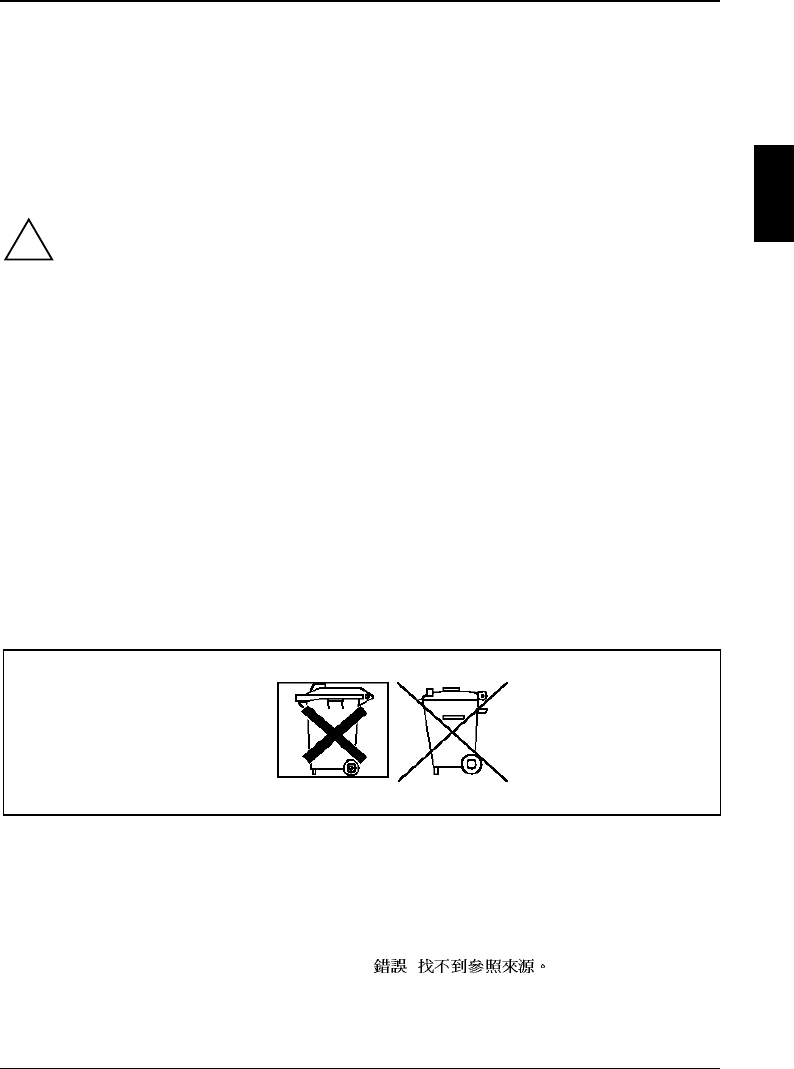
A26391-Kyyy-Z120-1-7619 3
Important notes
Here you will find essential safety information regarding your notebook. In addition, the manufacturer's
notes contain helpful information about your notebook.
Safety
!
Pay attention to the information provided in the manual "Safety and Warranty" and in the
following security notes.
Observe the sections in the manual marked with the symbol on the left.
• When connecting and disconnecting cables, observe the relevant notes in this operating manual.
• Only use batteries designed for this notebook.
Do not store batteries for longer periods in the notebook.
Take care not to drop the batteries or otherwise damage their casing (fire risk).
If the rechargeable batteries are defective, they must not be used.
Do not touch the contacts of the batteries.
Never interconnect the positive and negative terminals of a battery.
Used batteries must be disposed of in accordance with local regulations (special waste).
• If a lithium battery (button cell) is installed in the notebook for real-time buffering, please note that:
The lithium battery may only be replaced by authorised, specially trained personnel. Incorrect
handling may lead to a risk of explosion.
The lithium battery may be replaced only with an identical battery or with a type recommended by
the manufacturer.
The lithium battery must be disposed of in accordance with local regulations concerning special
waste.
• All batteries containing pollutants are marked with one of the two symbols below (crossed-out
garbage can).
In addition, the marking is provided with the chemical symbol of the heavy metal decisive for the
classification as a pollutant.
Cd Cadmium
Hg Mercury
Pb Lead
• During installation and before operating the device, please observe the instructions on
environmental conditions in the chapter entitled " ! " as well as the
instructions in the chapter "Preparing the notebook for use".
• When cleaning the device, please observe the relevant notes in the paragraph "
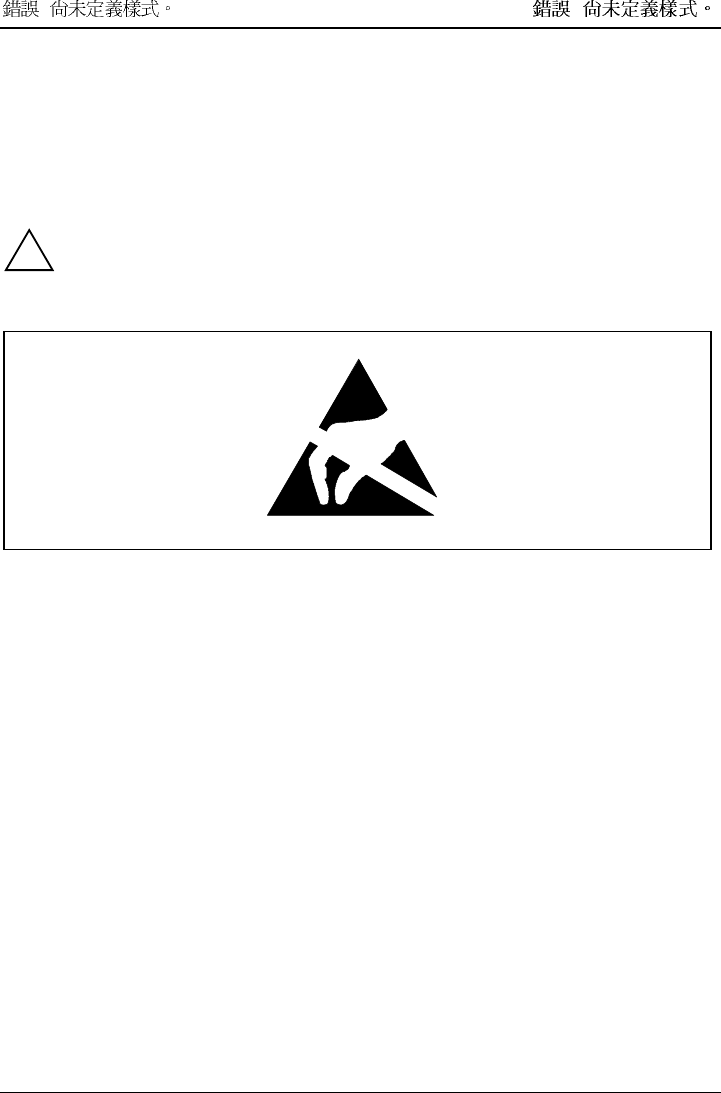
! !
4
Cleaning the notebook".
This notebook complies with the relevant safety regulations for data processing equipment. If you have
questions as to whether you can set up the notebook in the intended environment, please contact your
sales point or our Hotline/Help Desk.
Notes on installing and removing boards and modules
!Only qualified technicians should repair the device. Unauthorised opening or incorrect repair
may greatly endanger the user (electric shock, fire risk).
Boards with electrostatic sensitive devices (ESD) are identifiable by the label shown.
When you handle boards fitted with ESDs, you must, under all circumstances, observe the following
points:
• You must statically discharge yourself before working with boards (e.g. by touching a grounded
object).
• The equipment and tools you use must be free of static charges.
• Remove the power plug from the mains supply before inserting or removing boards containing
ESDs.
• Always hold boards with ESDs by their edges.
• Never touch pins or conductors on boards fitted with ESDs.
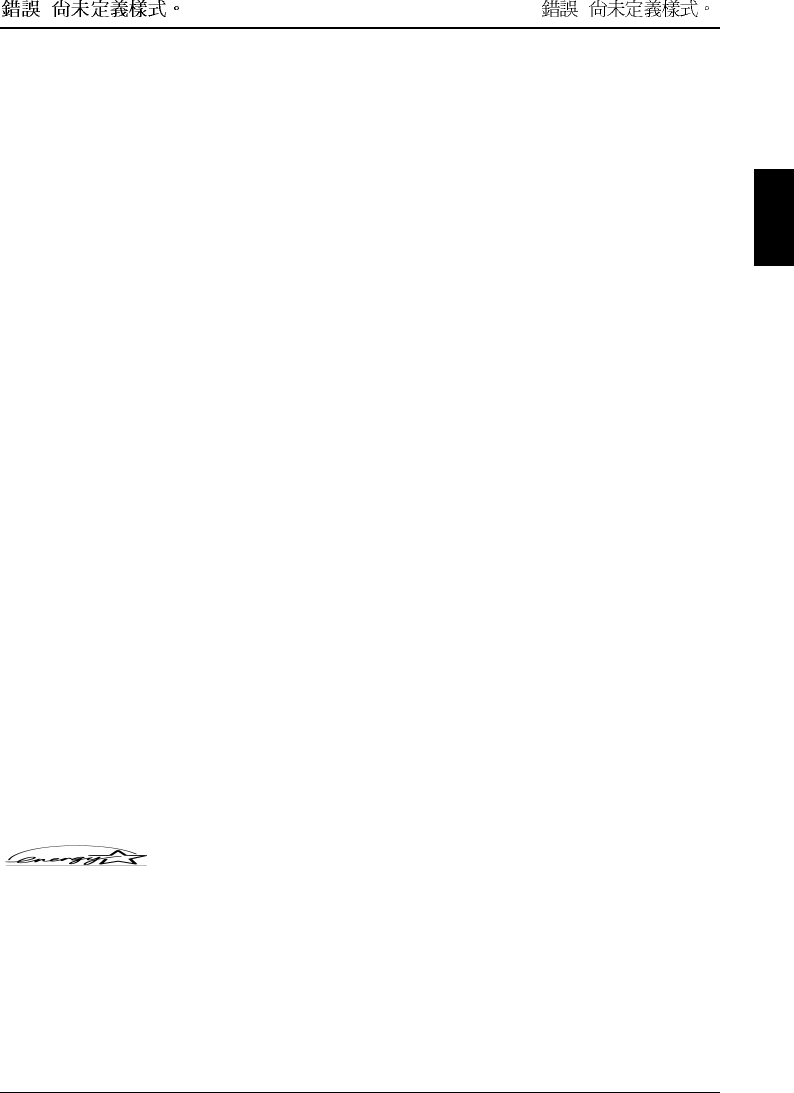
! !
A26391-Kyyy-Z120-1-7619 5
Notes on diation Exposure Statement
This device and its antenna(s) must operate with a separation distance of at least 20 cm from all
persons and must not be co-located or operating in conjunction with any other antenna or transmitter.
End-users must be provided with specific operating instructions for satisfying RF exposure compliance.
Manufacturer’s notes
Keep this operating manual together with your device. If you pass on the device to third parties, you
should include this manual.
Copyright-protected technology
This product incorporates copyright protection technology that is protected by method claims of certain
U. S. patents and other intellectual property rights owned by Macrovision Corporation and other rights
owners. Use of this copyright protection technology must be authorised by Macrovision Corporation,
and is intended for home and other limited viewing uses only unless otherwise authorised by
Macrovision Corporation. Reverse engineering or disassembly is prohibited.
Energy saving
If you will not be using your notebook, switch it off.
Make use of the device's energy saving functions (see "Working with your notebook"). The notebook
uses less power when the power management features are enabled. You will then be able to work for
longer before having to recharge the battery.
Energy saving under Windows
If a monitor with energy saving features is connected to your notebook, you can use the Screen Saver
tab to activate the energy saving features of the monitor. Select the following item in the start menu:
Settings - Control Panel - Display - Display Properties - Screen Saver - Energy saving functions for the
display. You can set additional energy saving functions in the start menu by selecting the following
item: Settings - Control Panel - Energy - Extended.
Energy Star
The notebook from Fujitsu Siemens Computers is designed to conserve
electricity by dropping to less than 8 W when it goes into standby/suspend
mode and to less than 3 W when it goes into OFF mode. With this level of
power management, the notebook qualifies for the U.S. Environmental
Protection Agency's (EPA) Energy Star Computers award.
The EPA estimates that computer equipment uses 5 percent of all business electricity and that this is
growing rapidly. If all desktop PCs and peripherals enter a low-power mode when not in use, the overall
savings in electricity could amount to $ 2 milliard annually. These savings could also prevent the
emission of 20 million tons of carbon dioxide into the atmosphere - the equivalent of 5 million
automobiles.

! !
6
As an Energy Star Partner, Fujitsu Siemens Computers GmbH has determined that this product meets
the Energy Star guidelines for energy efficiency.
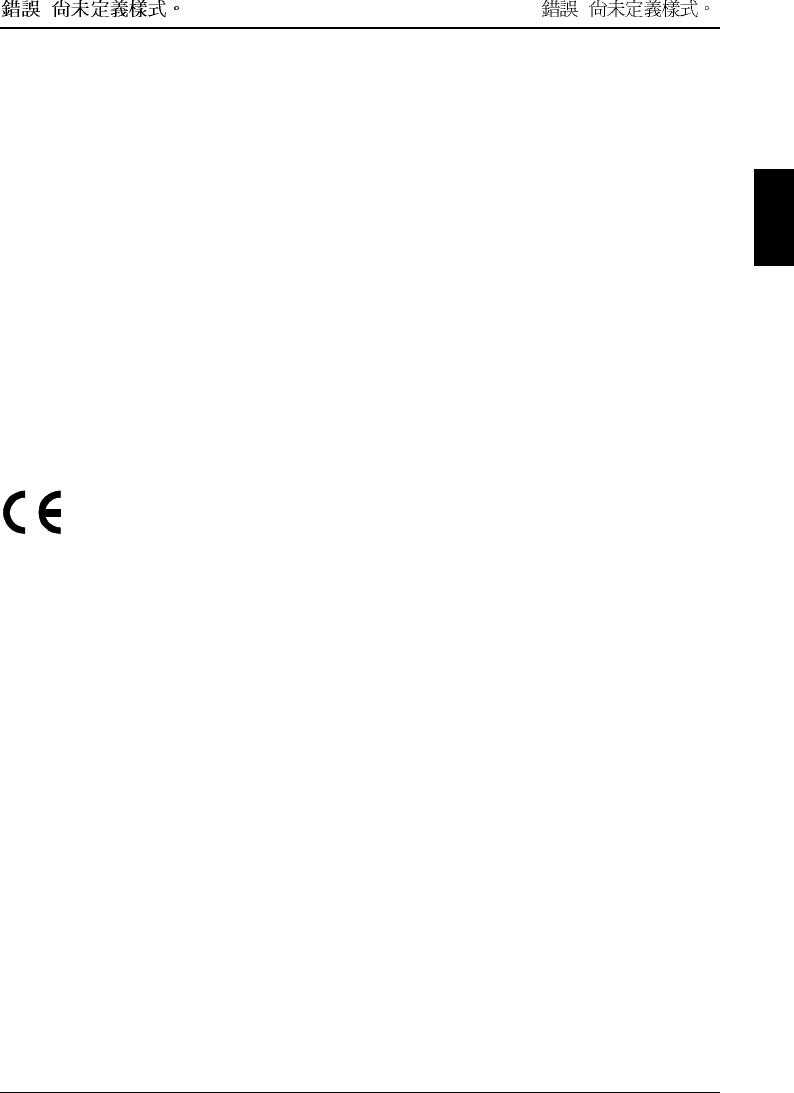
! !
A26391-Kyyy-Z120-1-7619 7
Disposal and recycling
This device has been manufactured to the highest possible degree from materials which can be
recycled or disposed of in a manner that is not environmentally damaging. The device may be taken
back after use to be recycled, provided that it is returned in a condition that is the result of normal use.
Any components not reclaimed will be disposed of in an environmentally acceptable manner.
Do not throw lithium batteries into the household waste. They must be disposed of in accordance with
local regulations concerning special waste.
If you have any questions on disposal, please contact your local office, our Hotline/Help Desk, or:
Fujitsu Siemens Computers GmbH
Recyclingcenter
D-33106 Paderborn
Tel: +49 5251 81 80 10
Fax: +49 5251 81 80 15
CE marking
The shipped version of this device complies with the requirements of the EEC directives
89/336/EEC "Electromagnetic compatibility" and 73/23/EEC "Low voltage directive".
GS symbol
In normal screen mode (dark characters against a light background) the LCD panel satisfies the
ergonomic requirements for the GS symbol.
FCC Class B
This equipment has been tested and found to comply with the limits for a Class B digital device,
pursuant to Part 15 of the FCC Rules. These limits are designed to provide reasonable protection
against harmful interference in a residential installation. This equipment generates, uses and can
radiate radio frequency energy and, if not installed and used in accordance with the instructions, may
cause harmful interference to radio communications. However, there is no guarantee that interference
will not occur in a particular installation. If this equipment does cause harmful interference to radio or
television reception, which can be determined by turning the equipment off and on, the user is
encouraged to try to correct the interference by one of the following measures:
- Reorient or relocate the receiving antenna.
- Increase the separation between the equipment and receiver.
- Connect the equipment into an outlet on a circuit different from that to which the receiver is
connected.
- Consult the dealer or an experienced radio/TV technician for help.
FCC Caution: To assure continued compliance, (example - use only shielded interface cables when
connecting to computer or peripheral devices). Any changes or modifications not expressly approved
by the party responsible for compliance could void the user's authority to operate this equipment. This
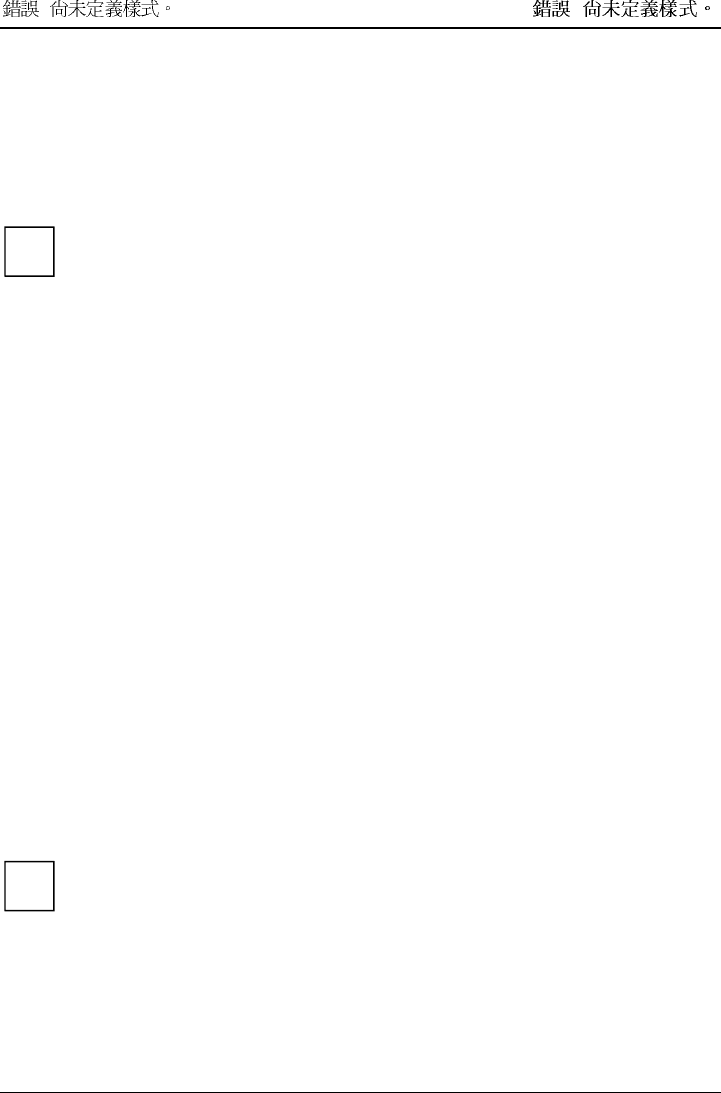
! !
8
device complies with Part 15 of the FCC Rules. Operation is subject to the following two conditions:
(1) This device may not cause harmful interference, and (2) this device must accept any interference
received, including interference that may cause undesired operation.
Battery storage
i
If you do not use the batteries for long periods, remove them from the notebook. Never store
the batteries in the unit.
Store the battery in a fully charged state. The battery should be stored in a dry area at a temperature
between 0°C and +30°C. The lower the temperature at which the batteries are stored, the lower is the
rate of self-discharge.
If storing for a long period of time (longer than two months) batteries should be fully charged before
storage.
To be able to use the optimum battery charging capacity, you should work in the battery mode until the
battery is completely discharged, and then recharge the battery.
Transporting the notebook
Please observe the points listed below when transporting your notebook.
Before you travel
• Copy important data from the hard disk onto a floppy disk.
• If you wish to use your notebook during a flight, first check with the flight attendants if it is
permissible to do so.
• If you are travelling abroad, ensure that the power adapter can be operated with the local mains
voltage. If this is not the case, obtain the appropriate power adapter for your notebook.
Do not use any other voltage converter!
i
If you travel in another country, check whether the local power supply and the specifications
of the power cable are compatible. If this is not the case, buy a power cable that matches
the local conditions. Do not use a connection adapter for electrical devices to connect the
notebook.
If you use a modem, incompatibilities with the local telecommunications system may result.
Transporting the notebook
• Remove all data carriers (e.g. floppy disk, CD) from the drives.

! !
A26391-Kyyy-Z120-1-7619 9
• Switch off the notebook.
• Unplug the power adapter and all peripheral devices from the mains outlet.
• Disconnect the power adapter cable and the data cables of all peripheral devices.
• Close the LCD screen so that it locks into place.
• If the notebook needs to be shipped, use the original packaging or other suitable packaging to
protect it from damage caused by mishandling.
• To protect against damaging jolts and bumps, use a notebook carrying case to transport your
notebook.
• Protect the notebook from severe shocks and extreme temperatures (e.g. direct sunlight in a car).

! !
10
Cleaning the notebook
Ê Switch off the notebook.
Ê Pull the power plug of the network adapter out of the mains outlet.
Ê Remove the battery.
How to remove the battery is described in the section "Inserting and removing the battery".
!Do not clean any interior parts yourself; leave this job to a service technician.
Do not use any cleaning agents that contain abrasives or may corrode plastic.
Ensure that no liquid enters the notebook.
Wipe the casing with a dry cloth.
If particularly dirty, use a cloth that has been moistened in mild domestic detergent and then carefully
wrung out.
To clean the keyboard and the touchpad, you can use disinfectant wipes.
Wipe the LCD screen with a soft, moistened cloth.

A26391-Kyyy-Z120-1-7619 11
Preparing the notebook for use
!Please read the chapter "Important notes".
Before you can work with your notebook, you need to charge the battery and install and configure the
delivered software. The operating system and required drivers are preinstalled.
Upon delivery, the battery can be found in the battery compartment and is not charged. You need to
charge the battery if you want to operate your notebook with a rechargeable battery.
If you use the notebook in a normal office situation, run it from the mains using the power adapter.
Unpacking and checking the delivery
Ê Unpack all the individual parts.
Ê Check the delivery for damage incurred during transportation.
Ê Check whether the delivery agrees with the details in the delivery note.
i
Should you discover that the delivery does not correspond to the delivery note, notify your
local sales outlet immediately.
Do not discard the original packing material of the devices. Keep the original packing
material in case you need to ship the equipment again.
Switching on the notebook for the first time
When you switch on your notebook for the first time, the supplied software is installed and configured.
You should plan some time for this, as this process must not be interrupted.
!Do not place it on a soft surface (e.g. a carpet or soft furnishings). The space between the
notebook's feet must be clear. Place the notebook on a flat, stable, nonslippery surface.
Do not place the power adapter on heat-sensitive material.
The notebook and the power adapter should be at least 200 mm apart.
Keep other objects 100 mm away from the notebook and its to ensure adequate ventilation.
Never cover the fan intake or exhaust openings of the notebook or the power adapter.
The power cable supplied conforms to the requirements of the country in which you
purchased your notebook. Make sure that the power cable is approved for use in the country
in which you intend to use it.
The power adapter's AC cord should only be connected to a mains outlet if the notebook is
already connected to the power adapter.
Do not expose the notebook to extreme environmental conditions. Protect it from dust,
humidity and heat.
Upon delivery, the battery can be found in the battery compartment and is not charged.
Ê Place the notebook on a flat, stable, nonslippery surface.
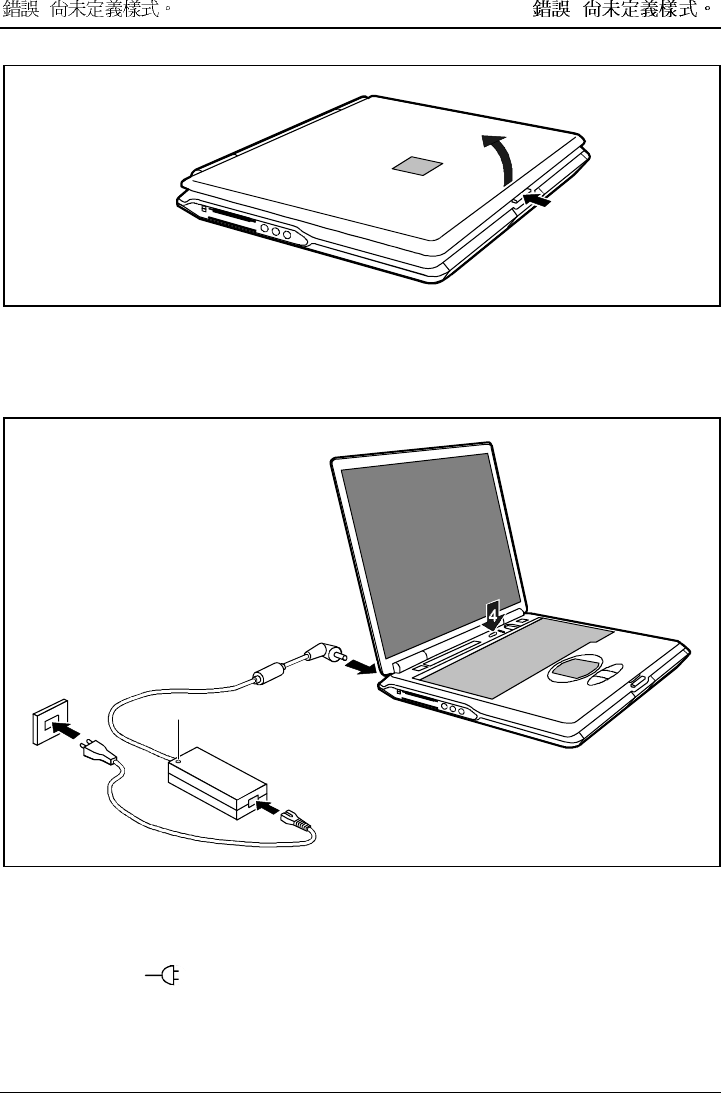
! !
12
2
1
Ê Press the release button (1) and open the LED display panel (2).
Connecting the power adapter and switching on the notebook
2
3a
1
Ê Connect the power adapter cable to the DC jack (DC IN) of the notebook (1).
Ê Connect the power cable to the power adapter (2).
Ê Plug the power cable into the mains supply (3).
The power indicator on the notebook and the indicator on the power adapter (a) should
illuminate. The battery is charging.
Ê Press the Suspend/Resume button (4), and release it again.
The Suspend/Resume button functions like an ON/OFF switch.
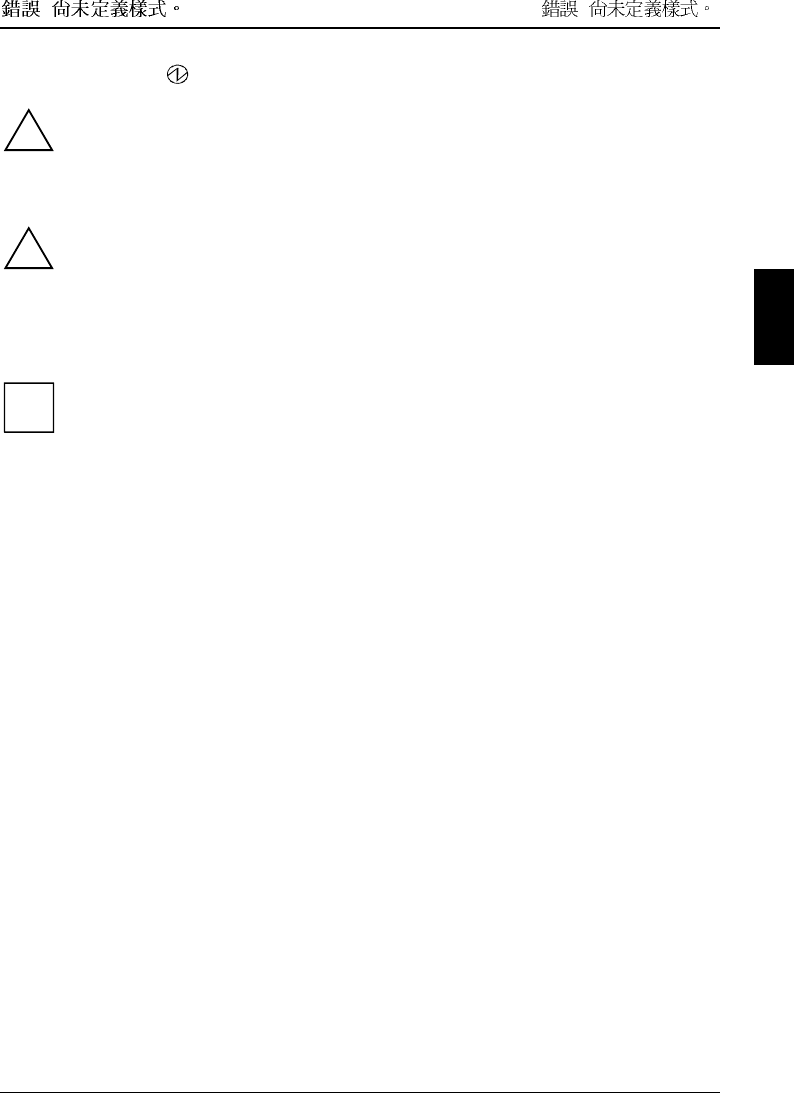
! !
A26391-Kyyy-Z120-1-7619 13
The power-on indicator on the notebook lights up.
!
After switch-on a self-test (POST, Power On Self Test) is automatically carried out. Never
switch the notebook off during the self-test.
First-time software installation
!Leave the external power adapter connected to your notebook during the initial installation.
Once the installation has been started, the notebook must not be switched off!
During installation the notebook may only be rebooted when you are requested to do so!
Ê During installation, follow the instructions on screen.
Consult the operating system manual if there is anything unclear about the requested input data.
i
You will find further information about the system, drivers, utilities, updates, manuals etc. on
the "Drivers & Utilities" CD supplied.
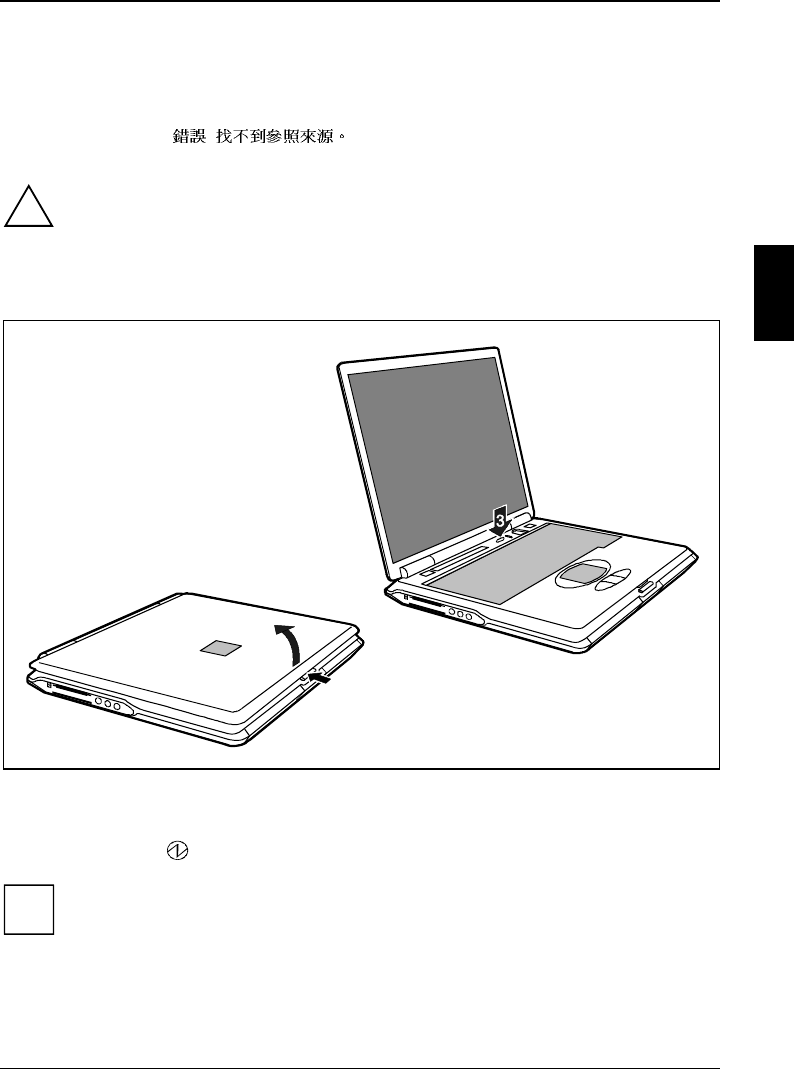
A26391-Kyyy-Z120-1-7619 15
Working with your notebook
This chapter describes the basics for operating your notebook.
Please see the chapter " ! " for instructions on how to connect devices such as
a mouse and a printer to the notebook.
!Please take note of the information in the chapter "Important notes".
Switching on the notebook
2
1
Ê Press the release button (1) and open the LED display panel (2).
Ê Press the Suspend/Resume button to switch on the notebook (3).
The power-on indicator on the notebook lights up.
i
You can configure the Suspend/Resume button under Start - Settings - Control Panel - Power
Options - Power Options Properties.
If you have assigned a password, in order to start the operating system you must enter this
password when requested to do so,.
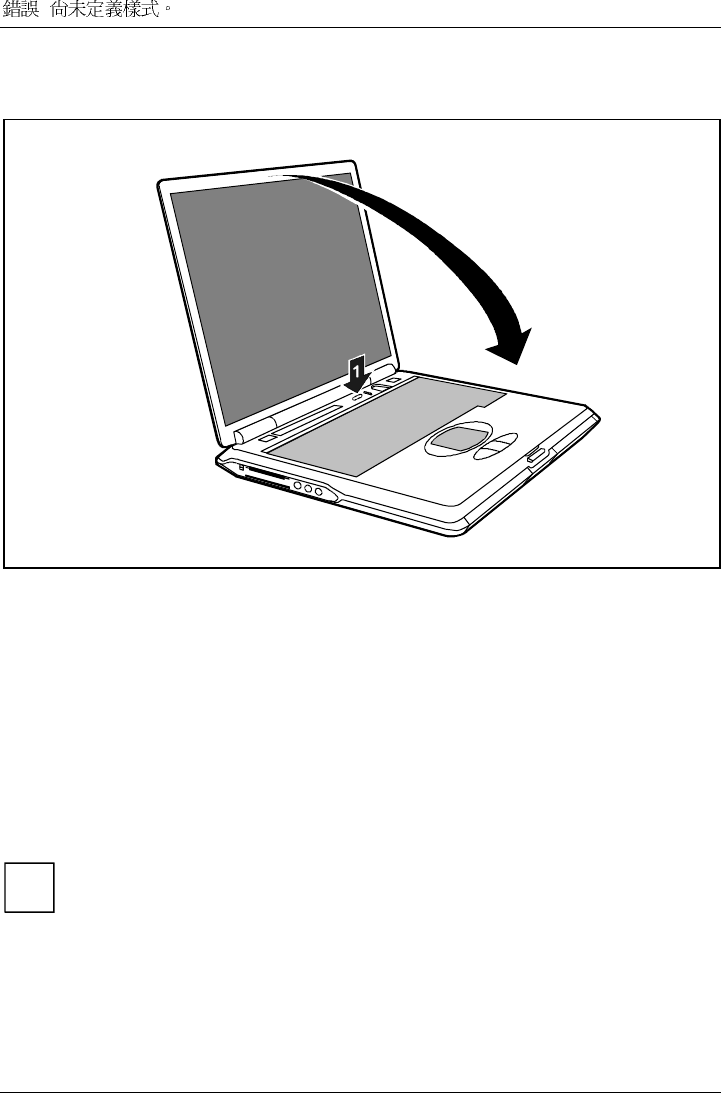
!
16
Switching off the notebook
2
Ê Shut down the operating system properly.
If the notebook is not switched off automatically, press the Suspend/Resume button (1) and
release it again.
Ê Immediately press the Suspend/Resume button again once, and hold it down for approximately
four seconds until you hear an acoustic signal.
Ê Close the LCD screen of the notebook (2) so that it locks into place.
Switching off notebook via operating system
How you can switch off your notebook via the operating system is dependent on the settings of the
power-management feature. Additional information is contained in the section "Using the power-
management features" in this chapter.
i
Save all open files before switching the notebook into the Standby mode to avoid data loss
when the notebook remains switched off for a longer time.
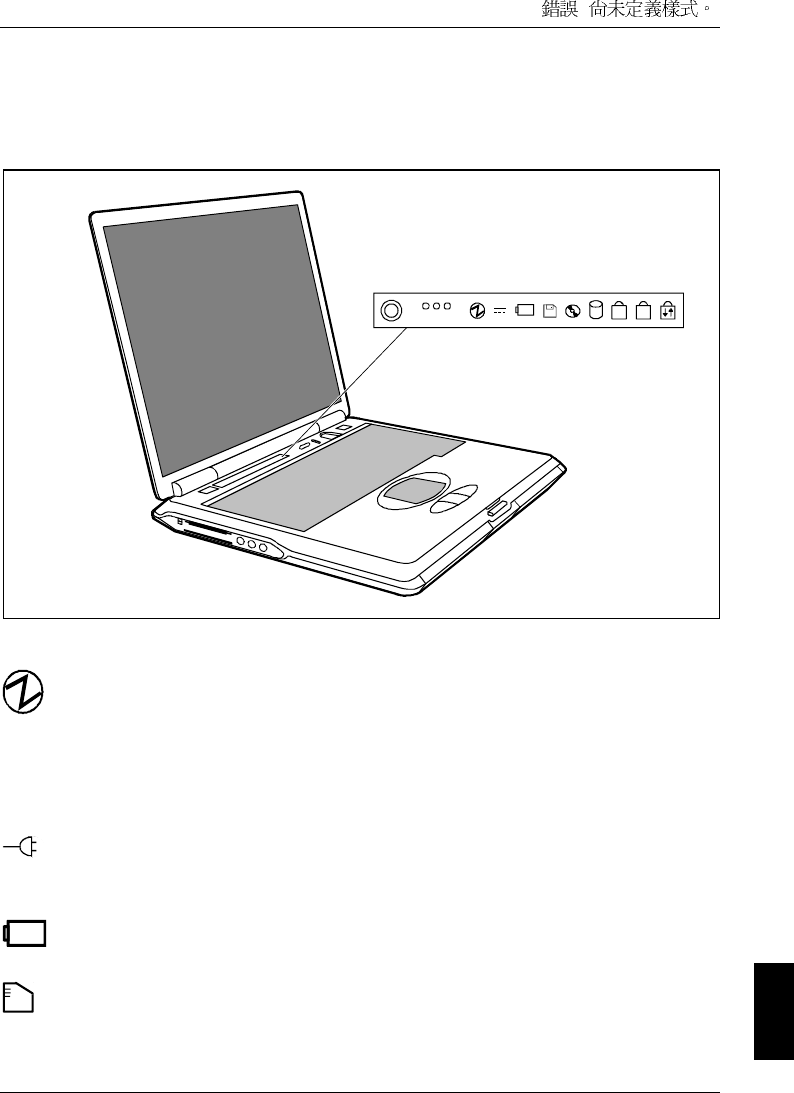
!
A26391-Kyyy-Z120-1-7619 17
Indicators
The following icons appear in the display field of your notebook:
A1
The meanings of the symbols are as follows:
Power-on indicator
• The indicator lights up: The notebook is on.
• The indicator flashes (1 second on / 1 second off):
The notebook is in energy-saving mode.
• The indicator is dark:
The notebook is switched off.
Power indicator
The power adapter is supplying power to the notebook.
07% Battery indicator
The battery charging state is indicated in the status indicator panel.
1Indicator PC card 1
The indicator lights up when a PC card disk in slot 1 is being accessed.
You must not remove the PC card from the slot when this indicator is lit.
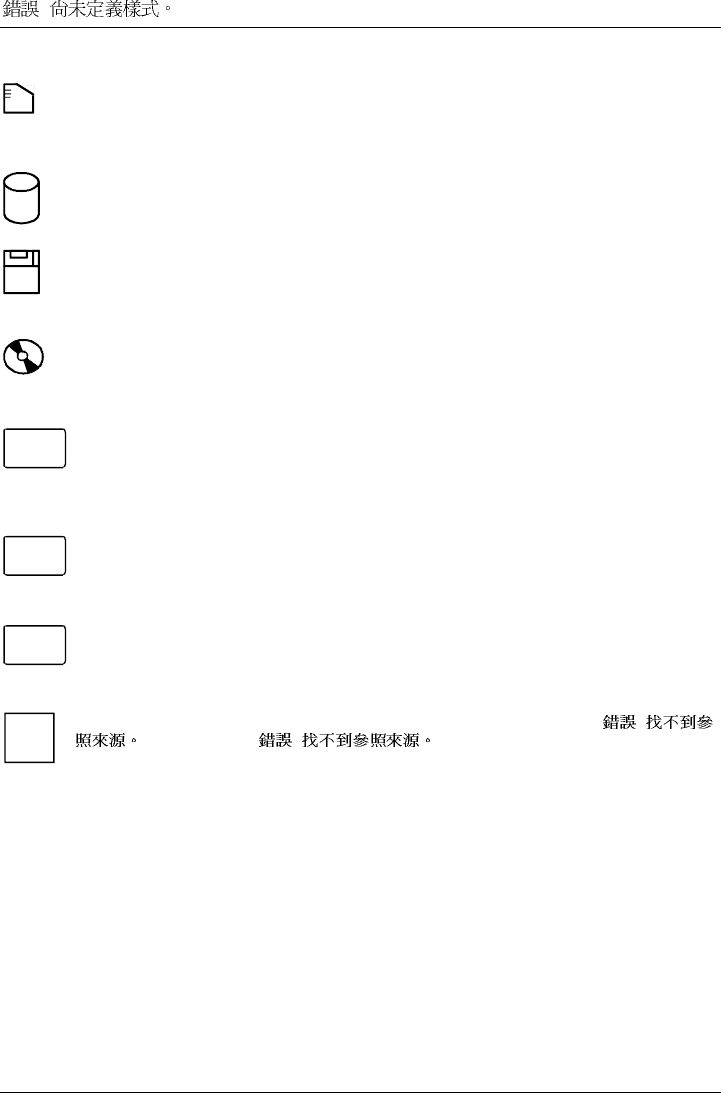
!
18
2Indicator PC card 2
The indicator lights up when a PC card disk in slot 2 is being accessed.
You must not remove the PC card from the slot when this indicator is lit.
Hard disk indicator
The indicator lights up when the hard disk drive is being accessed.
Floppy disk drive indicator
The indicator lights up when a floppy disk in the floppy disk drive is being accessed.
You must not remove the floppy disk from the floppy disk drive when this indicator is lit.
Optical drive indicator
The indicator is lit when the CD/DVD in the optical drive is being accessed.
You must not remove the CD/DVD from the drive when this indicator is lit.
CapsLK CapsLK indicator (Caps Lock)
The Ï key has been pressed. All the characters you type appear in uppercase. In the case
of overlay keys, the character on the upper left on the keycap appears when that key is
pressed.
ScrLK Scroll indicator (Scroll Lock)
The [Scr] key has been pressed. The effect this key has varies from programme to
programme.
NumLK NumLK indicator (Num Lock)
The key combination [Fn] + [Num LK] has been pressed. The numbers on the lower left on
keys in the integrated numeric keypad are enabled.
i
Information on the displays of the security panel is contained in the chapter " !
", in the section " ! ".
Keyboard
The following description of keys refers to Windows. Additional functions supported by the keys are
described in the relevant manuals supplied with your application programmes.
The figure below shows how to access the different characters on keys with overlaid functions. The
example applies when the CapsLK indicator is not lit.
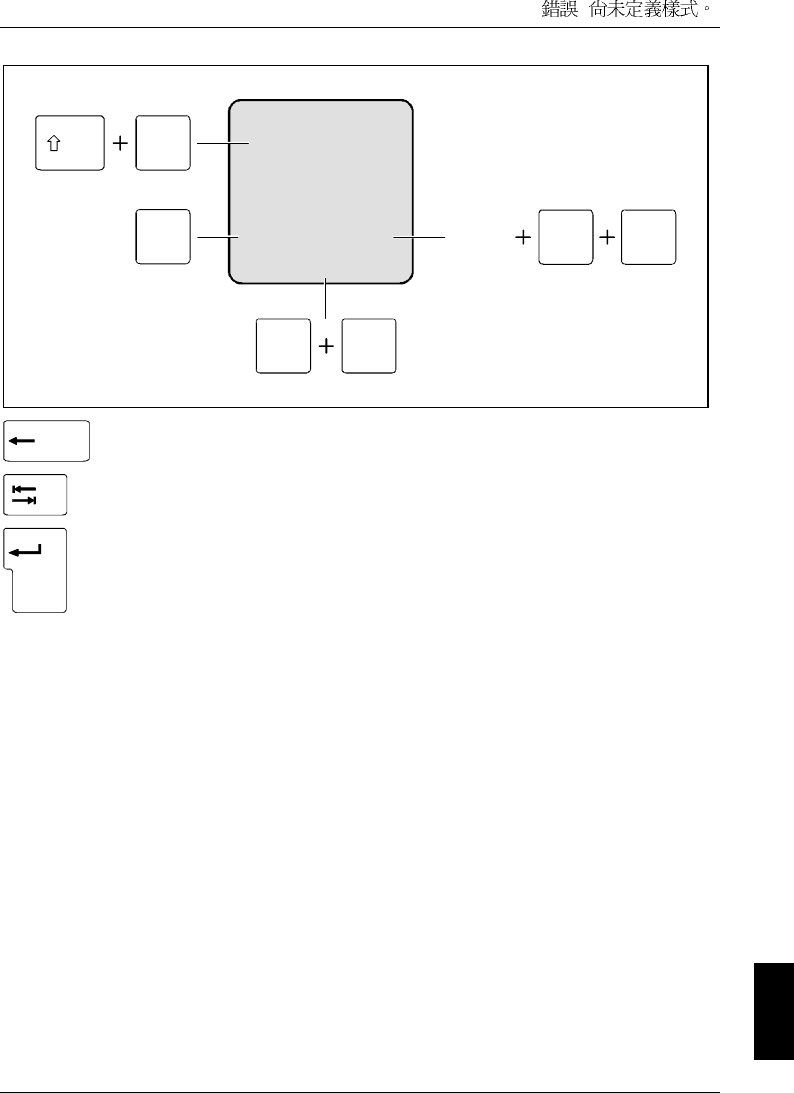
!
A26391-Kyyy-Z120-1-7619 19
7
/
{7
7
/
{7
7
/
{7
Alt Gr 7
/
{7
Fn 7
/
{7
NumLk
Backspace key
The Backspace key deletes the character to the left of the cursor.
Tab key
The Tab key moves the cursor to the next tab stop.
Enter key (return, enter, line feed, carriage return)
The enter key terminates a command line. The command you have entered is
executed when you press this key.
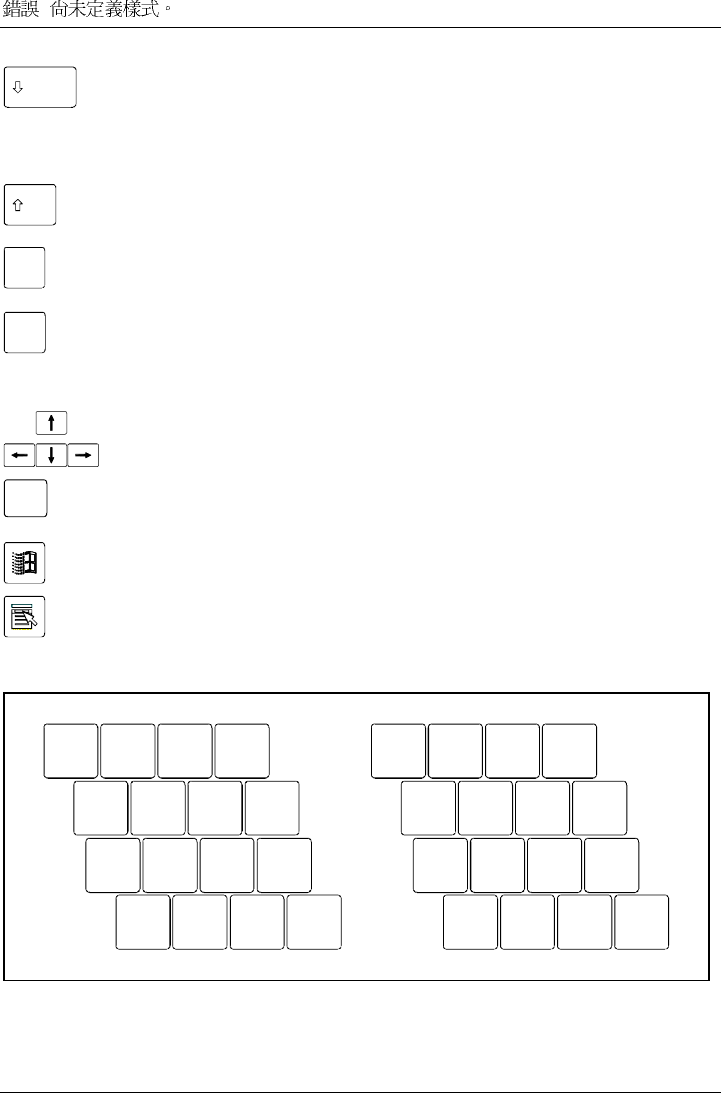
!
20
Caps Lock key
The Caps Lock key activates uppercase mode (CapsLK indicator lit). The Caps Lock
function causes all the characters you type to appear in uppercase. In the case of
overlay keys, the character on the upper left on the keycap appears when that key is
pressed.
To cancel the Caps Lock function, simply press the Caps Lock key again.
Shift key
The Shift key causes uppercase characters to appear. In the case of overlay keys, the
character on the upper left of the keycap appears when that key is pressed.
Alt Gr Alt Gr key
The [Alt Gr] key causes the characters in the lower middle of the keycap to appear
(e.g. { in the case of the [7] key on the German keyboard).
Fn Fn key
The [Fn] key enables the special functions indicated on overlay keys (see "Key
combinations").
If the external keyboard does not feature an [Fn] key, you can simultaneously press
the [Ctrl] + [Alt Gr] keys or the [Ctrl] + [Alt] keys.
Cursor keys
The cursor keys move the cursor in the direction of the arrow, i.e. up, down, left, or
right.
Untbr
Pause
Pause key
The [Pause] key temporarily suspends display output. Output will resume when you
press any other key.
Start key
The Start key invokes the Windows Start menu.
Menu key
The Menu key invokes the menu for the marked item.
Numeric keypad
7890
UI OP
J
M
K
;
L
:_
Ö
/
{
(
[
)
]
=
}
µ, . -
1
789 *
456-
123+
0/.
2
1 = Characters enabled when NumLK indicator is not lit (see "

!
A26391-Kyyy-Z120-1-7619 21
Indicators").
2 = Characters enabled when NumLK indicator is lit (see "

!
22
Indicators").
If the numeric keypad is enabled (NumLK indicator is lit) and you hold down the [Fn] key, you can
output the characters printed in blue on the bottom right of the keys.
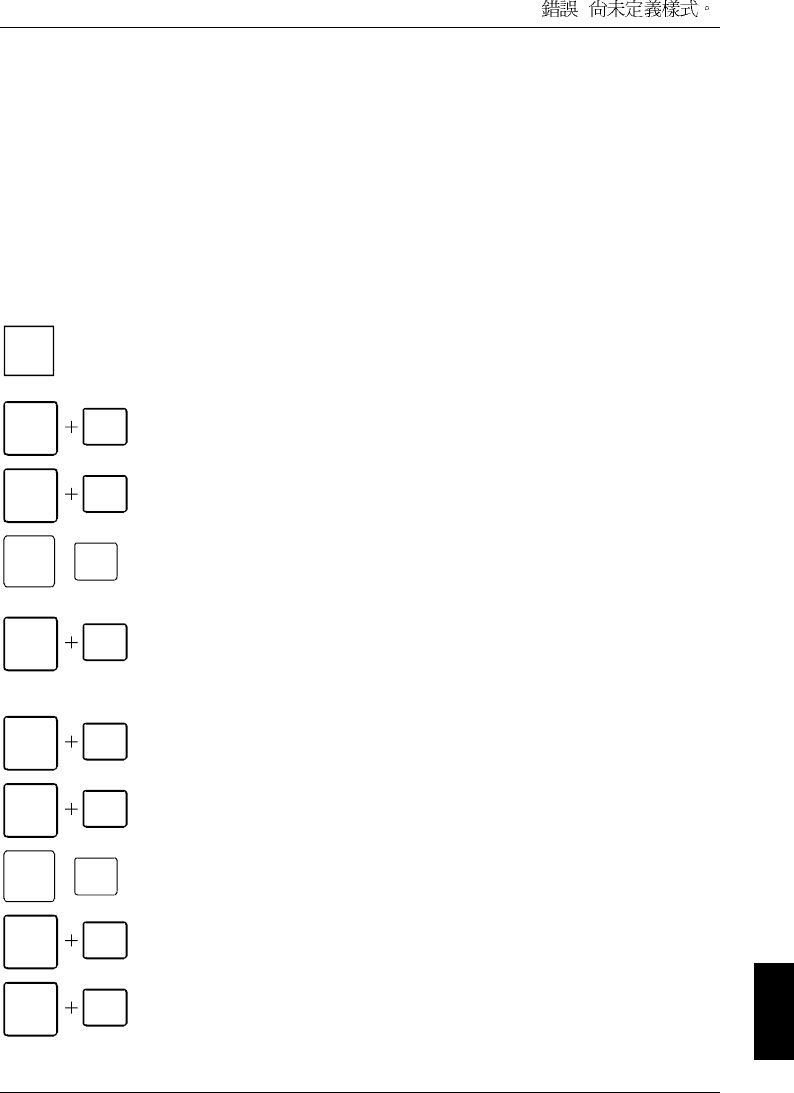
!
A26391-Kyyy-Z120-1-7619 23
Key combinations
The following description of key combinations refers to functions when using Microsoft Windows. Some
of the following key combinations may not function in other operating systems and with some device
drivers.
Other key combinations are described in the relevant manuals supplied with your application
programmes.
Key combinations are performed as follows:
Ê Press and hold the first key in the combination.
Ê While keeping the first key pressed, press the other key or keys in the combination.
i
If the external keyboard does not feature an [Fn] key, you can simultaneously press
the [Ctrl] + [Alt Gr] keys or the [Ctrl] + [Alt] keys.
Fn F2 Undocking
This key combination prepares the device for undocking off the Port Replicator.
Fn F3 Enlarge MS-DOS screen
This key combination enlarges the screen in the MS-DOS mode to the full-screen
mode or switches it back to the normal display mode.
F4
Fn +Switch internal touchpad on/off
This key combination enables and disables the touchpad function.
To do this, set the setting Internal Pointing Device to Auto Disabled in the BIOS
Setup in the menu Advanced - Keyboard/Mouse Features.
Fn F5 Switching on the Speed Skp© mode
This key combination switches between the possible Speed Skp© modes:
− Maximum power
− Battery optimised power (reduced processor speed during battery
mode)
Fn F6 Switching the loudspeakers on/off
This key combination switches your notebook's integrated loudspeakers off and
on.
Fn F7 Increasing the volume
This key combination raises the volume of the integrated loudspeakers.
F8
Fn +Reducing the volume
This key combination decreases the volume of the integrated loudspeakers.
Fn F9 LCD off
This key combination switches off the LCD monitor to save energy.
Fn F11 Increasing the display brightness
This key combination increases the brightness of the display.
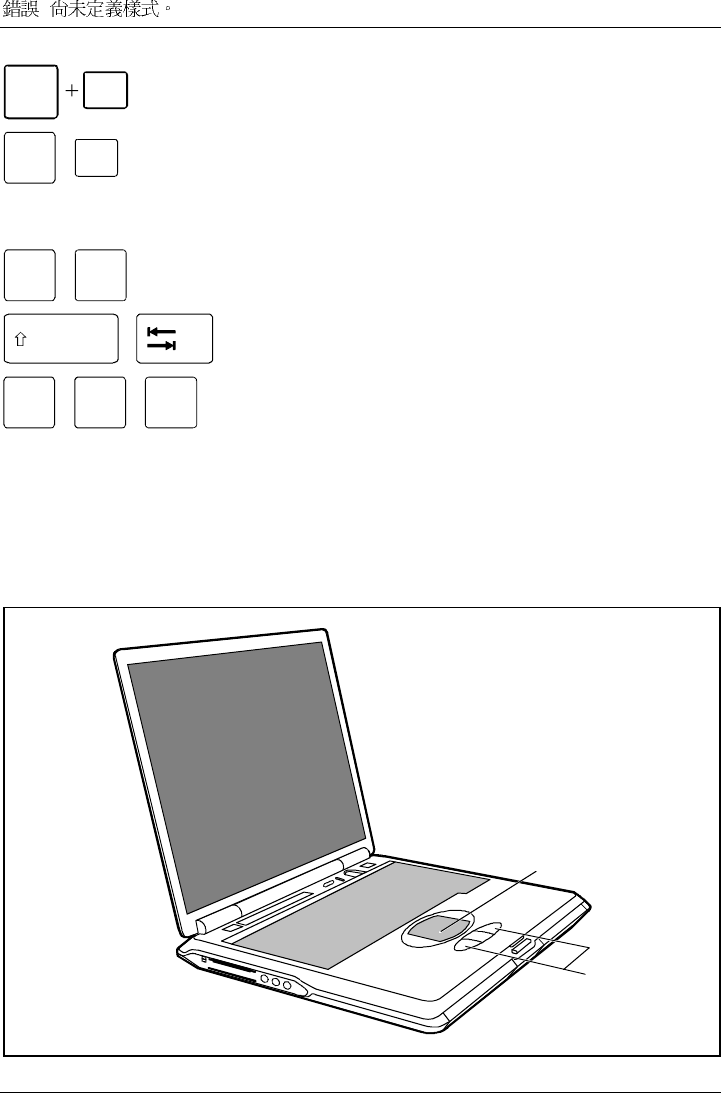
!
24
Fn F12 Reducing the display brightness
This key combination reduces the brightness of the display.
Fn +F10 Switching between internal and external screen
If an external monitor is connected, the monitor on which the output is to be
displayed can be selected with this key combination. You can opt to use:
• just the notebook's internal display
• just the external display
• both the internal and the external display.
Strg +C
Halting the current operation
This key combination can be used to halt an operation instantly without clearing
the keyboard buffer.
+
Backtab (Shift+Tab)
This key combination moves the cursor back to the previous
tabular stop.
Strg +Alt +Entf Carrying out a warm boot
This key combination triggers a reset and warm-boots the
notebook. First hold down the [Ctrl] and [Alt] key, and then
press the [Del] key. With Windows 98, Windows 2000,
Windows ME and Windows NT Task Manager appears first.
Then you must press all three keys again to re-boot.
Touchpad and touchpad buttons
The touchpad enables you to move the mouse pointer on the screen. The two touchpad buttons allow
the selection and execution of commands. They correspond to the buttons on a conventional mouse.
1
2

!
A26391-Kyyy-Z120-1-7619 25
1 = Touchpad 2 = Touchpad buttons
Moving the pointer
Ê Move your finger on the touchpad.
Selecting
Ê Tap the touchpad once or press the left button once.
Executing a command
Ê Tap the touchpad twice or press the left button twice.
Dragging an object
Ê Move the pointer to the item you wish to select.
Ê Select the desired object, and leave your finger on the touchpad.
Ê Drag the object to the desired position.
Ê Lift your finger from the touchpad.
Display settings
Setting the desktop area
You can change the screen resolution under Start - Settings- Control Panel - Display - Settings and then
selecting from the Resolution field.
Adjusting the font size
Under Start - Settings - Control Panel - Display - Settings you can choose between a larger and a smaller
font in the Font size field.
Setting the display brightness
You can adjust the brightness of your LCD screen with the keys [Fn] and [F11] or [Fn] and [F12]: With
[Fn] and [F12] you adjust the screen darker, and with [Fn] and [F11] brighter.
Synchronising the display on the LCD screen and an external monitor
Your notebook supports the simultaneous display on the LCD monitor and an external monitor. If the
picture does not appear correctly on the LCD monitor, press the key combination [Fn] + [F10] several
times, or switch the external monitor off and then on again. This achieves good picture synchronisation.
Adjusting the speed of the mouse pointer
You can change the speed of the mouse pointer under Start - Settings - Control Panel - Mouse and
clicking on the Motion tab.
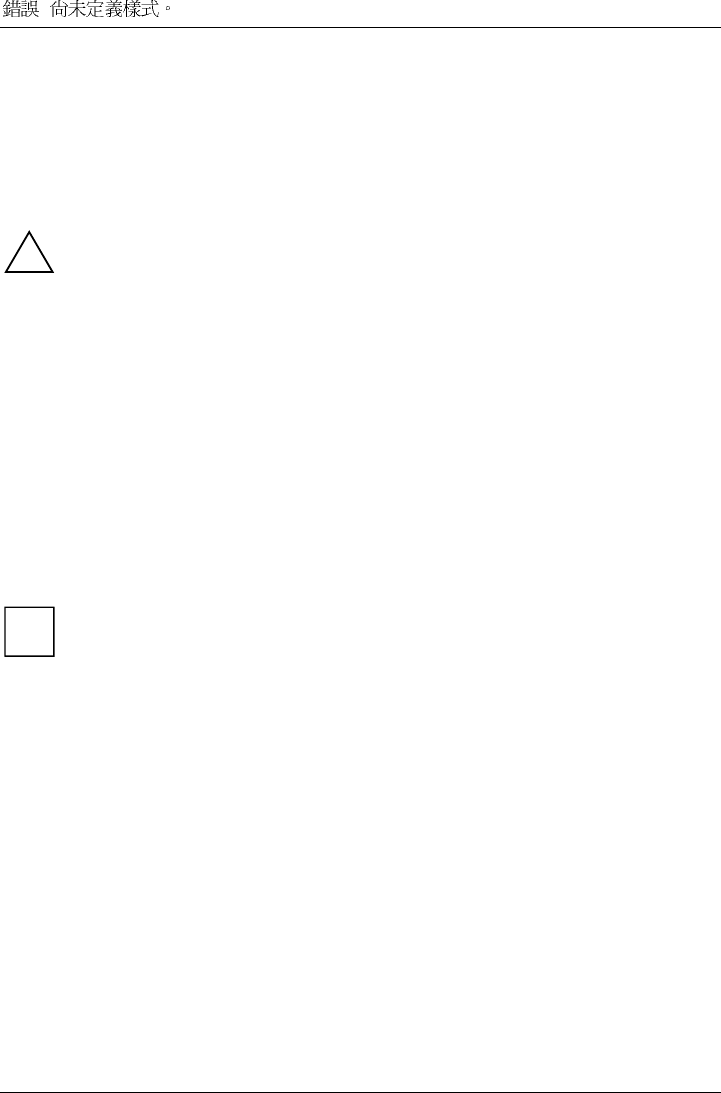
!
26
Battery
The battery is one of the most important components of your notebook. When not plugged into a mains
outlet, the notebook runs on its built-in battery. You can increase the life of the battery by caring for the
battery properly. The average battery life is around 500 charge/discharge cycles.
You can extend the battery life by taking advantage of the available energy saving functions.
!Only use batteries released for your notebook.
Take care not to drop the batteries or otherwise damage their casing (fire risk).
If the rechargeable batteries are defective, they must not be used.
Do not touch the contacts of the batteries.
Never interconnect the positive and negative terminals of a battery.
Used batteries must be disposed of in accordance with local regulations (special waste).
Observe the information on battery storage in the chapter "Important notes".
Performing the battery learning cycle
The battery contains electronics that continuously monitor the battery charging level and display the
current charging level. To compensate for measuring errors in the electronics, and because the
chemical properties of the battery change over time, the electronics must be recalibrated regularly. This
calibration is carried out using a battery learning cycle. Using the battery learning cycle ensures that
the maximum battery capacity can always be used. During the learning cycle a defined charging cycle
is carried out.
i
The battery learning cycle lasts between four and six hours and must not be aborted. During
this period you can not work with the notebook!
Ê Restart the notebook (switching ON/OFF or warm boot).
The following display briefly appears on the screen during start-up:
<ESC> Diagnostic screen <F12> Boot Menu <F2> BIOS Setup
Ê Press function key [F6].
The learning cycle is started. When the learning cycle is ended, a corresponding message is displayed.
Charging the battery
The battery indicator displays the remaining battery charge (see the section "

!
A26391-Kyyy-Z120-1-7619 27
Indicators"). When you switch on the notebook, it takes a few seconds before the battery status is
displayed.
You can charge the battery by connecting the notebook to the power adapter (see "Connecting the
power adapter and switching on the notebook").
The battery can only be charged when the ambient temperature is between 5°C and max. 35°C.
With the notebook switched on or off, the battery will completely recharge in approximately three to four
hours.
Work in the battery mode until an acoustic warning prompts you to recharge and the battery indicator
begins to flash. The notebook battery should not be charged before this point.
If you do not connect the power adapter within five minutes of the signals described above, your
notebook automatically switches itself off.
Monitoring charging time
The remaining battery charge is indicated by the battery symbol in the status indicator panel (see the
section "
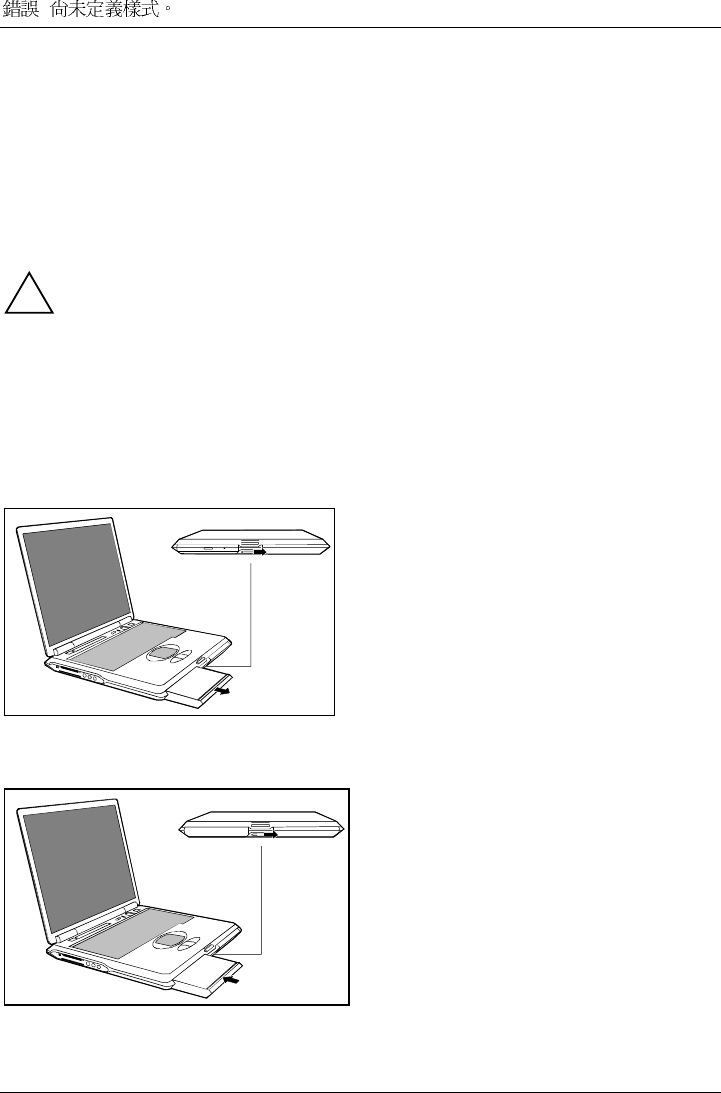
!
28
Indicators"). When you switch on the notebook, it takes a few seconds before the battery status is
displayed.
During mobile operation you can also use a "battery charge meter" for energy-saving monitoring under
Windows.
A battery icon is shown in the taskbar. When you position the cursor on the battery icon, the battery
charge level is displayed with a blue status bar. This blue bar progressively decreases as the battery
discharges.
Inserting and removing the battery
!Only use batteries released for this notebook.
Never use force when inserting or removing a battery.
Make sure that no foreign objects enter the slots.
Ê Switch off the notebook.
Ê Place the notebook on a flat surface.
Ê Open the LCD display panel.
Removing the battery
2
1
Ê Push the slide in the direction of the arrow up
to the stop (1).
Ê Pull the battery out of the casing in the
direction of the arrow (2).
Installing the battery
2
1
Ê Push the slide in the direction of the arrow up
to the stop (1).
Ê Position the battery at the edge of the
casing (2) and then press it into the notebook.
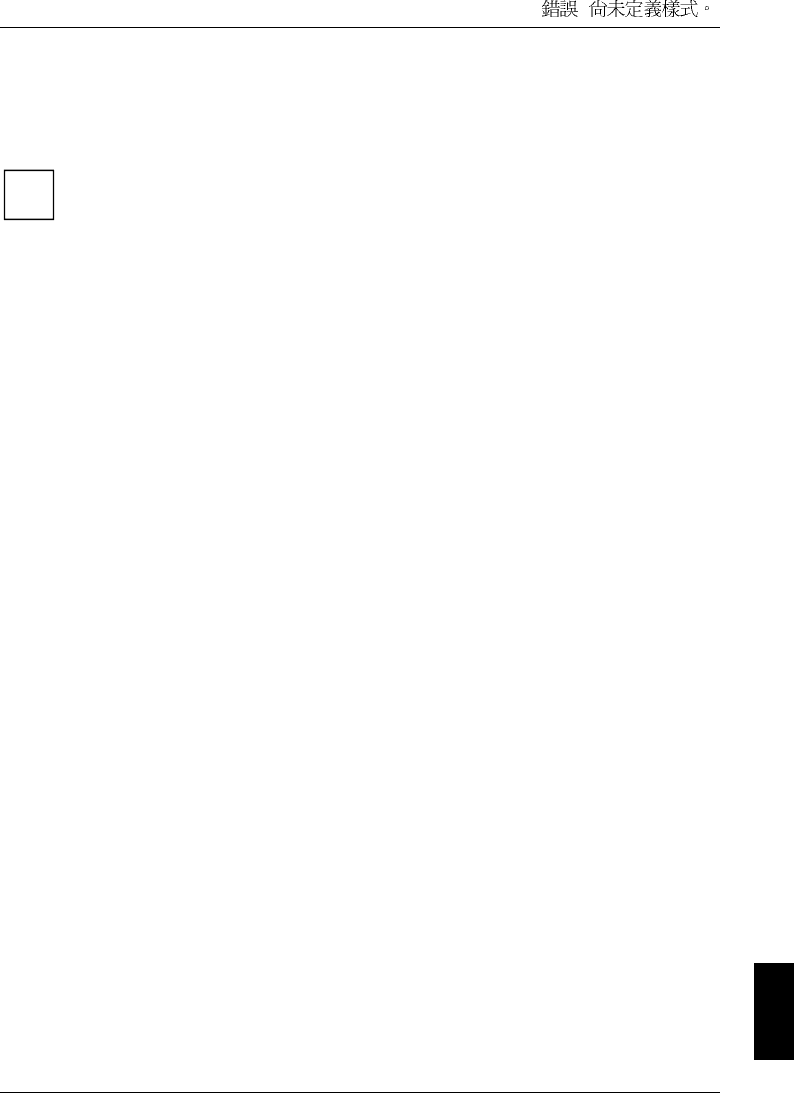
!
A26391-Kyyy-Z120-1-7619 29
Using the power-management features
The notebook uses less power when the power management features are enabled. You will then be
able to work longer when using the battery before having to recharge it.
i
If you are connected to a network or use the integrated modem, PC LAN card, or PC
modem card, we advise against enabling an energy saving mode. This could lead to an
interruption of your network connection.
When not using the notebook for long periods of time, first end the energy saving mode, then
switch off the notebook. Never switch off the notebook with the Suspend/Resume button
while the notebook is in one of the energy-saving modes.
If your notebook is in an energy-saving mode mode:
• Do not connect any external peripheral devices.
• Do not disconnect any external peripheral devices.
• Do not attempt to switch the notebook on if the built-in battery is flat.
• Do not change or remove the floppy disk, if inserted.
• Do not add or remove RAM.
• Do not add or remove a PC card.
• Do not replace or remove the battery.
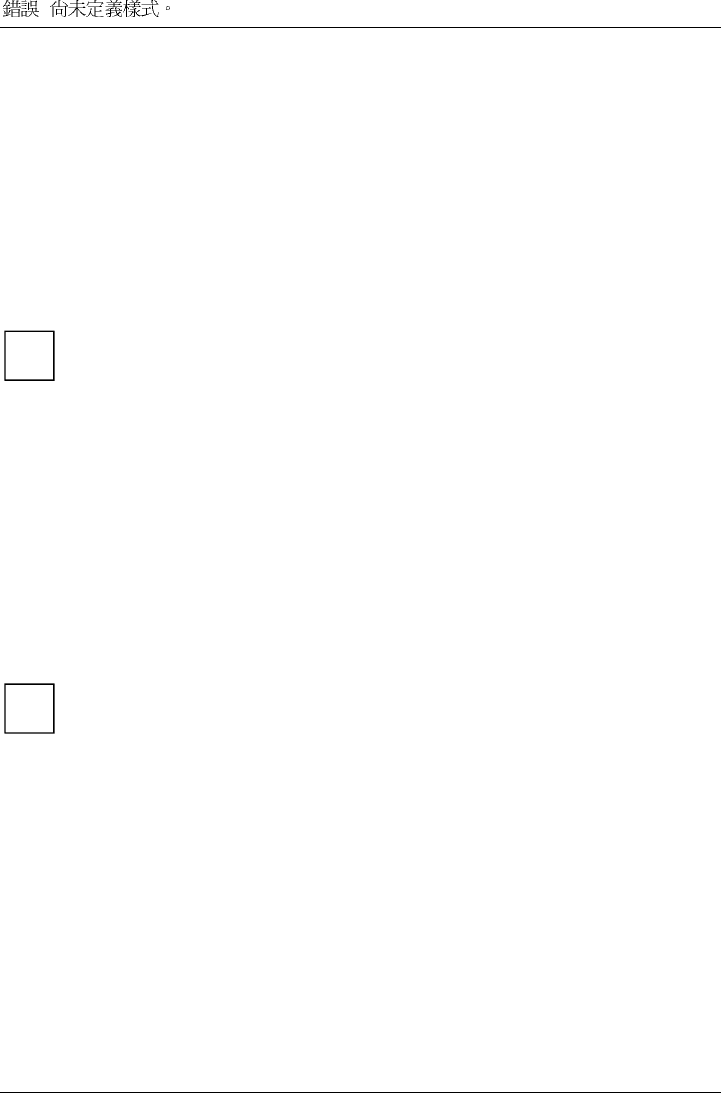
!
30
Energy-saving modes of notebook
You can set two energy-saving modes with your notebook.
In the Suspend mode (Suspend to DRAM/Standby) all current data (active programmes, files) are
buffered in the main memory, and in the Save-to-Disk mode (Save to Disk/HibernateMode) all current
data are saved on the hard disk. Then the notebook is switched off. After the notebook is switched on,
you can continue working exactly where you left off before.
Operating systems with ACPI
(Windows 98, Windows ME and Windows 2000)
i
For operating systems with ACPI you can set the energy-saving functions under Settings
- Control Panel - Power Management (e.g. Standby, Hibernate mode and LCD off).
You can configure the Suspend/Resume button and the lid switch in the Settings tab under
Settings – Control Panel – Power Management.
Settings for energy-saving functions in the BIOS Setup are not taken into account by
operating systems with ACPI.
Changing settings
Ê Double-click on the My Computer symbol.
Ê Double-click on the Control Panel symbol.
Ê Double-click on the Power management symbol in the Control Panel window.
The Properties dialogue field appears.
Ê Adjust the setting to your needs.
Ê Click on OK to save the settings.
i
With Windows 2000 and Windows ME the Hibernate mode is switched off in the default
setting.
With Windows 98 please read the chapter "PHDISK (for Windows 98 and Windows NT
only)".
Additional information on this service programme is contained in the help function of Windows 98 and
Windows 2000.
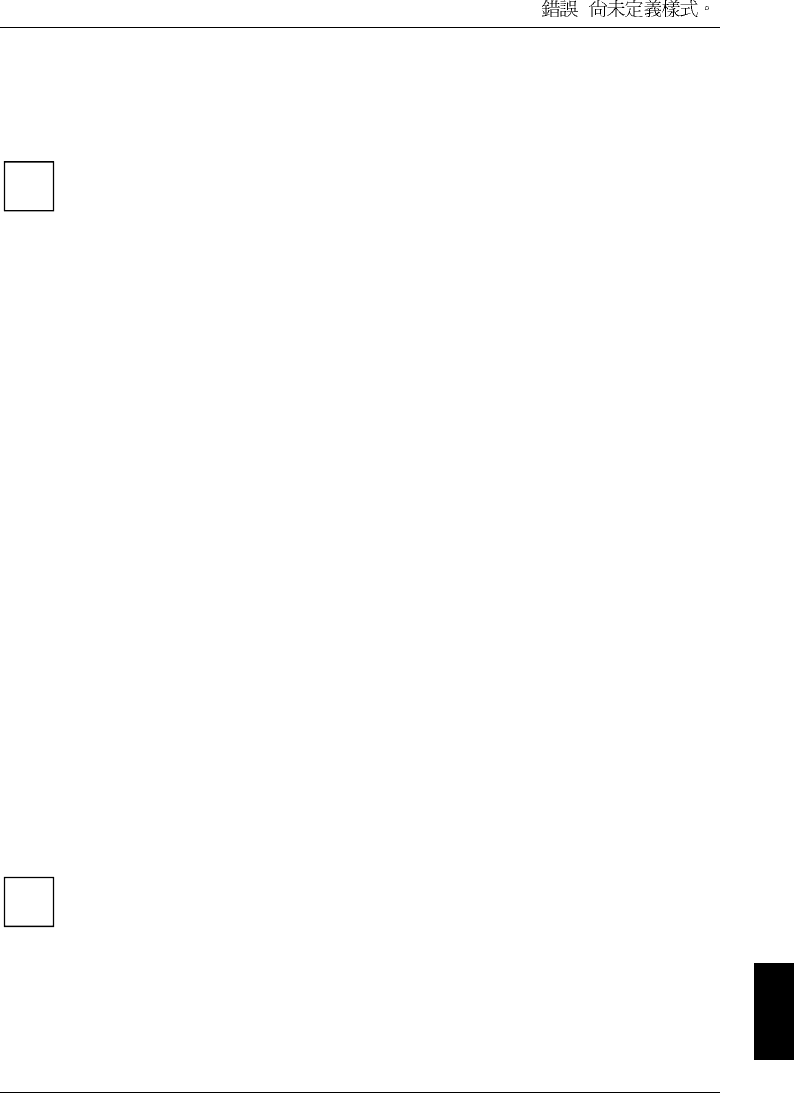
!
A26391-Kyyy-Z120-1-7619 31
Operating systems with APM (Windows 95, Windows NT with APM
extensions)
i
For operating systems with APM (Advanced Power Management) you can set the energy-
saving functions in the BIOS Setup (e.g. Suspend to RAM, Save to Disk, LCD off etc.).
Setting energy-saving modes
Ê Call the BIOS Setup.
Ê Set which energy-saving mode you want to use in the Power menu.
Ê Set the Auto Suspend Timeout parameter in the Power menu to a time period after which the
notebook is to be switched into the energy-saving mode.
Suspend to DRAM
In this mode the current data in the main memory (DRAM) is stored. The data is stored for as long as
the notebook is supplied with energy. If the battery is full, the data is stored for a matter of days.
Without a battery and without a power supply the current data is lost.
Save to Disk
So that the current data can be saved, sufficient memory must be available on the hard disk. If the
operating system Windows NT or OS/2 Warp is used, a Save-to-Disk partition must be created on the
hard disk (see manual for respective operating system).
In this case also see the section "PHDISK (for Windows 98 and Windows NT only)".
PHDISK (for Windows 98 and Windows NT only)
The PHDISK service programme reserves the memory space required for the use of Save-to-Disk
mode. The programme creates a file or partition for saving the main memory contents and the system
register when your notebook is switched over to Save-to-Disk mode. The positions of the first and last
free sectors are saved in the CMOS after running this programme.
• Run PHDISK after you have installed or removed memory modules.
• Run PHDISK after you have installed or restored Windows 98.
• Run PHDISK after you have replaced your hard disk.
• Run PHDISK if you have received a BIOS error message in conjunction with Save-to-Disk mode
during the self test (POST).
i
In Windows NT the PHDISK service programme is not supported by the NTFS file system.
In Windows 2000/ME the required memory space on the hard disk is not reserved until you
make the required Hibernate mode settings under Settings - Control Panel - Power
Management.
Running PHDISK
Ê Click on Start and then Shut down in Windows.
Ê Activate the Start computer in MS-DOS mode checkbox and click on Yes.

!
32
Ê Enter CD\UTILITY\PHDISK at the DOS prompt and press the Enter key.
Ê Enter PHDISK after the DOS prompt.
Ê Follow the instructions on the screen.
i
Be sure to define a sufficiently large partition.
If you require additional information on the programme parameters, enter PHDISK or PHDISK /INFO
at the DOS prompt.
!We recommend that you use the considerably more flexible option FILE when running
PHDISK. We discourage the use of the PARTITION option, as the safety of the data already
saved on the hard disk is not ensured.
Additional power-management features
Closed cover switch
When you close the LCD display panel, the notebook switches into Standby mode. Opening the LCD
display panel ends Standby mode.
Ê Set the value On in the BIOS Setup in the Power - Advanced Features menu for the Lid Closure
Suspend parameter if your notebook is to go into the energy-saving mode when the lid is folded
down.
Ê If the energy-saving mode is to be ended again by folding up the LCD screen, then also set the
LidOpen Resume parameter to On.
Power Button
You can configure the Suspend/Resume button.
If you want to use the Suspend/Resume button as an ON/OFF switch, set the Power Button parameter
to Power Off in the Power - Advanced Features menu in the BIOS Setup.
Standby Timeout
With this mode you switch off the LCD screen and internal components after a defined period of time.
Any activity automatically returns the notebook to normal operation.
Hard Disk timeout
With this mode the motor of the hard disk drive is switched off as soon as no activity with the keyboard
or the pointing device, or any other input or output activity takes place for a time period defined in the
BIOS Setup.
This parameter is set in the Power menu in the BIOS Setup. When the hard disk is accessed, the motor
of the hard disk drive is automatically switched on again.
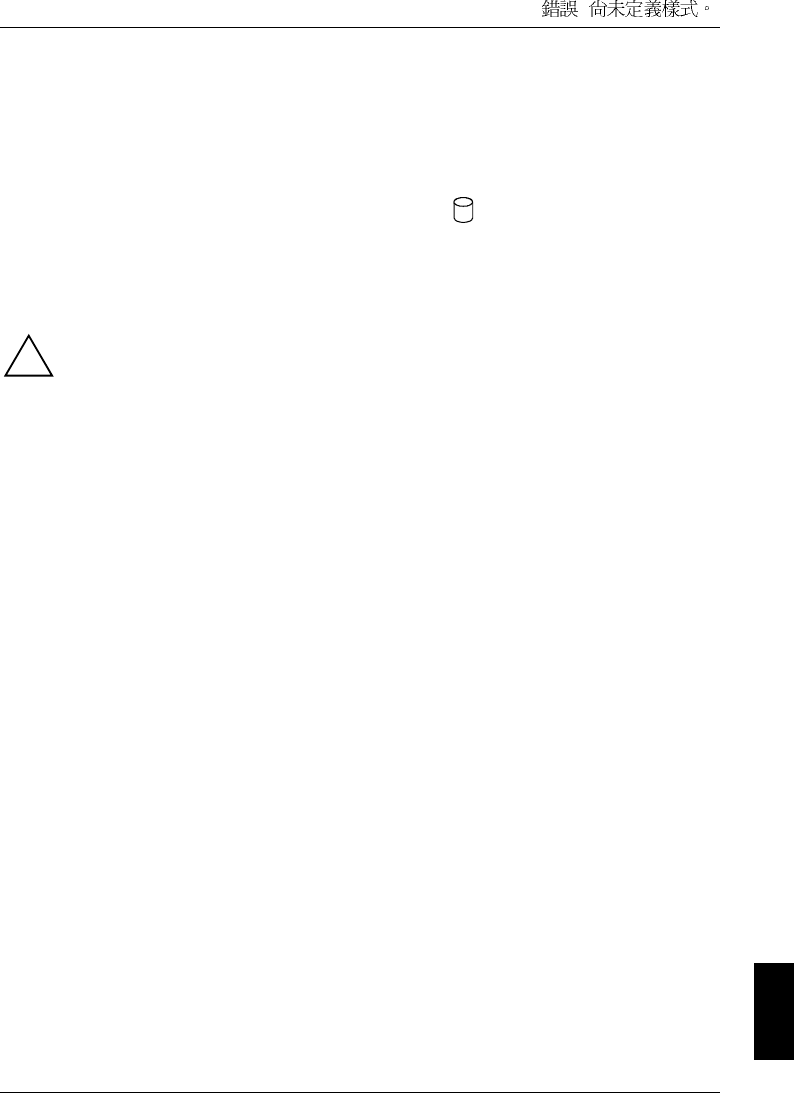
!
A26391-Kyyy-Z120-1-7619 33
Hard disk
The hard disk is the most important storage medium of your notebook. You can work considerably
faster and more efficiently if you copy applications and files from floppy disks or CDs to your hard disk.
When the hard disk is accessed, the hard disk indicator lights up .
Inserting and removing modules
Modules can be optical drives, additional hard disk or floppy disk drives or batteries.
!Only use modules released for this notebook.
Do not use force when installing or removing a module.
Make sure that no foreign objects enter the slots.
Ê Switch off the notebook.
Ê Place the notebook on a flat surface.
Ê Open the LCD display panel.
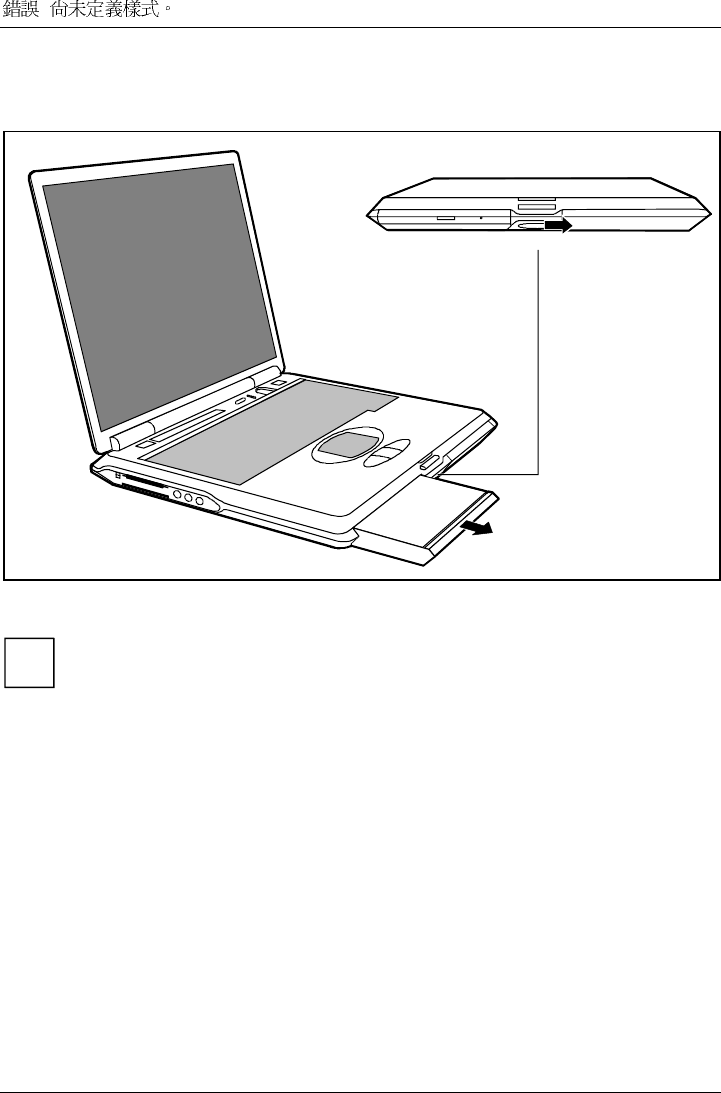
!
34
Removing modules
2
1
Ê Push the slide in the direction of the arrow up to the stop (1).
i
Before removing the left module, slide the release button to the right. Before removing the
right module, slide the release button to the left.
Ê Remove the module the direction of the arrow (2).
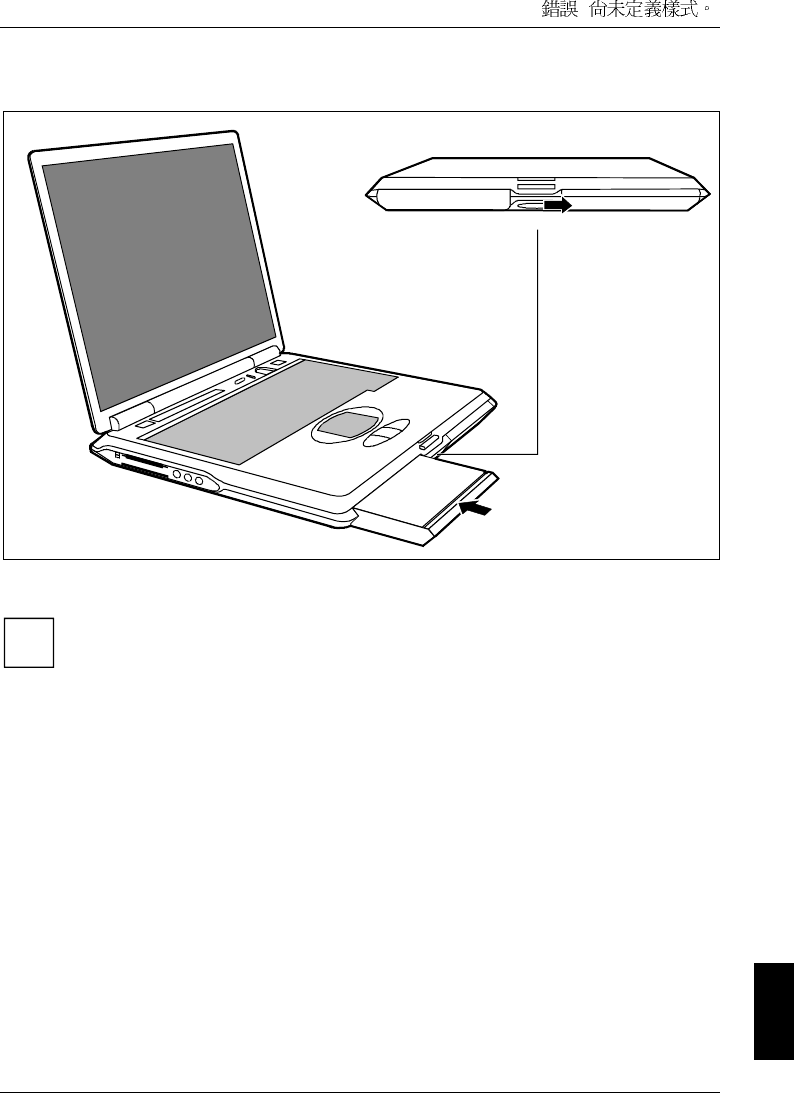
!
A26391-Kyyy-Z120-1-7619 35
Installing modules
2
1
Ê Push the slide in the direction of the arrow up to the stop (1).
i
Before removing the left module, slide the release button to the right. Before removing the
right module, slide the release button to the left.
Ê Position the module at the edge of the casing (2) and then press it into the notebook.
Ê Release the slide (2).
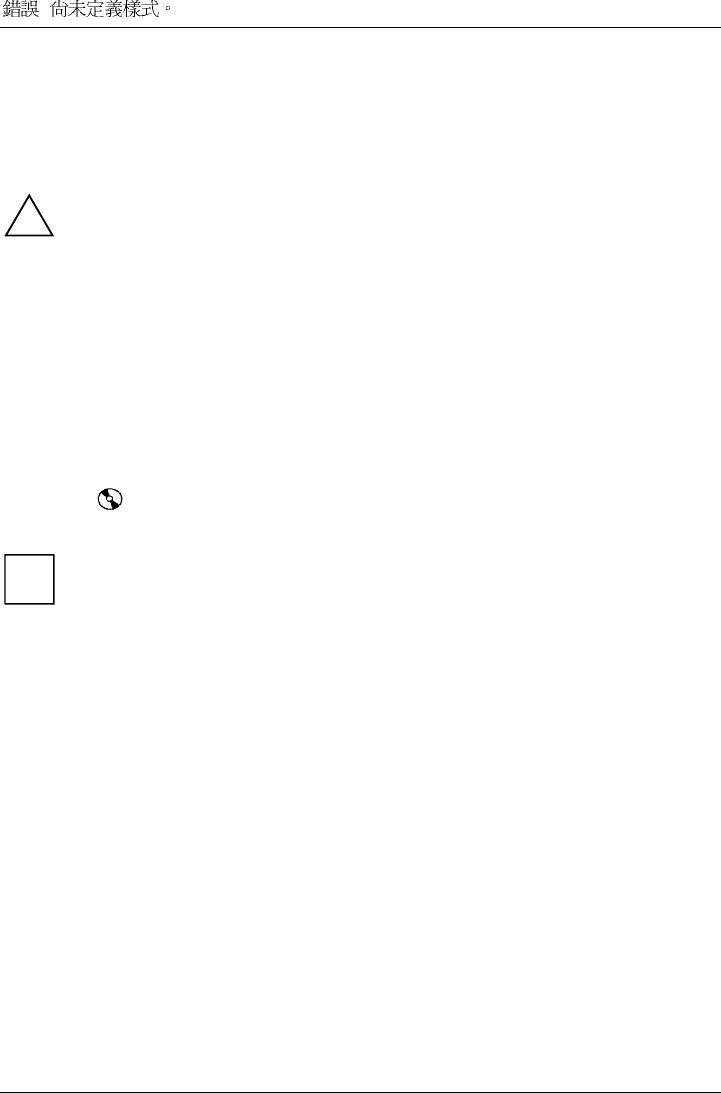
!
36
Optical drives
Depending on the model, your notebook is equipped with a CR-ROM drive, a CD-RW drive, or a DVD-
ROM drive.
!This device contains a light-emitting diode, classified according to IEC 825-1:1993: LASER
CLASS 1, and must not be opened.
Avoid touching the surface of a CD/DVD. Handle CDs/DVDs only by their edges!
Always store CDs/DVDs in their cases. Thus you avoid dust contamination, scratches,
bending or other damage.
Protect your CDs/DVDs from dust, mechanical vibration and direct sunlight!
Avoid storing a CD/DVD in areas subject to high temperatures or humidity.
You may use both 8-cm and 12-cm CDs/DVDs in the optical drive.
When using CDs/DVDs of minor quality vibrations and reading errors may occur.
Optical drive indicator
The indicator flashes when a CD/DVD is inserted. The indicator goes out when the drive is ready-
to-operate. The indicator lights up when the drive is accessed.
i
If the indicator does not go out after the CD/DVD is inserted, and continues to flash, the
CD/DVD is probably damaged or dirty.
Inserting or removing a CD/DVD
The notebook must be switched on.
Ê Push the insert/eject button (1).
The drive tray will open.
Ê Pull the drive tray completely out.
Ê Place the CD/DVD in the drive tray with the label facing upwards.
or
Ê Take out an inserted CD/DVD.
Ê Push in the drive tray until you feel it lock into place.

!
A26391-Kyyy-Z120-1-7619 37
Manual removal (emergency removal)
In the event of a power failure or damage to the drive it may be necessary to manually remove the
CD/DVD.
Ê Switch off the notebook.
Ê Push a pen or a piece of wire (such as a paper clip) into the opening for manual ejection.
The drive tray is unlocked. You can now pull the drive tray out of the drive.
i
Where the opening for manual ejection is located please refer to the documentation of the
drive.
Floppy disk drive
!Never clean the floppy disk drive with cleaning disks. Any attempt would destroy the
read/write head in the disk drive within 20 seconds.
Make sure that no floppy disk is inserted in the floppy disk drive during transport. Otherwise
the eject button may break off and the floppy disk drive will be damaged.
Working with floppy disks
i
Follow the instructions supplied by the vendor of the floppy disks.
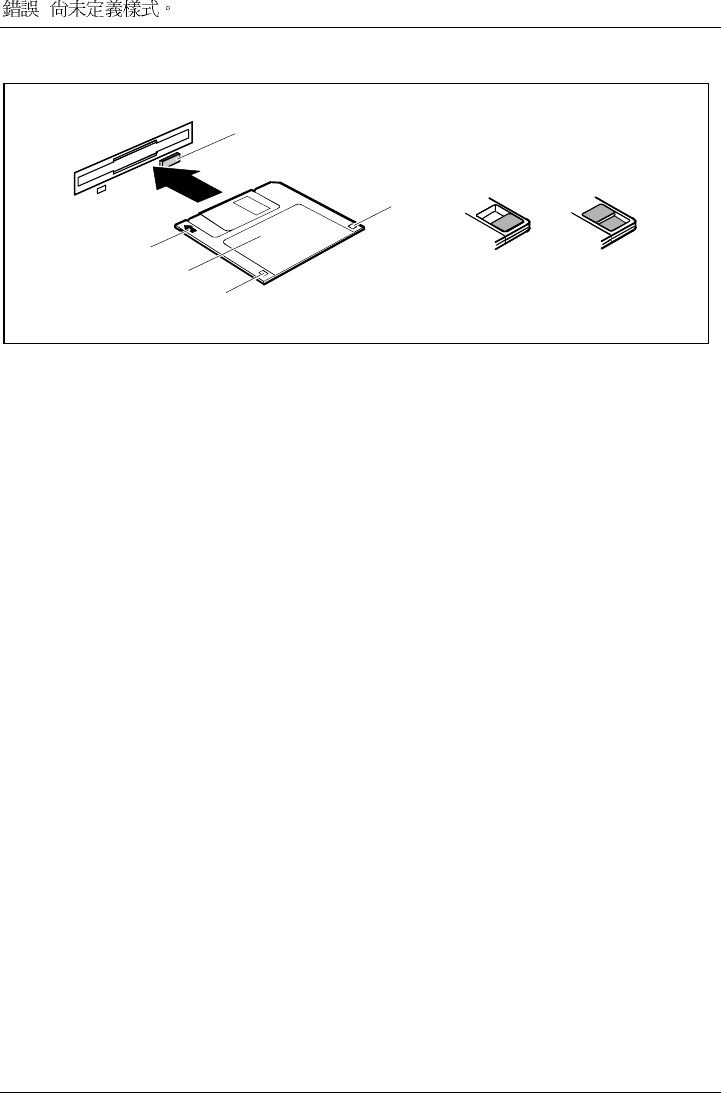
!
38
3
2
1
5
6
47
1 = Insertion direction
2 = Label area
3 = Write protection tab for a 1.44 Mbyte floppy disk
4 = Identification of a 1.44 MB floppy disk or write protect switch on a 120 MB floppy disk
5 = Eject button for inserted floppy disks
6 = Disk is write-protected
7 = Disk is not write-protected
To insert a diskette:
Ê Push the floppy disk into the drive in the insertion direction (1) until it engages. The label should
be facing upward.
To remove a diskette:
Ê Push the eject button (5).
Protect the floppy disk against being overwritten or erased
Ê Slide the write-protect slider into position (6). The hole is now visible.
Deactivate write protection
Ê Slide the write-protect slider into position (7). The hole is now covered.
Integrated 56k modem
Depending on the device version, a modem may already be installed in your notebook. The integrated
56k modem supports all data communication applications, such as:
• Modem operation: High-speed downloads at up to 56,000 bit/s (V.90). Downward-compatible to
V.34 modems.
• Fax mode: Transmitting and receiving at up to 14,400 bit/s
• Simple country adaptation with programme
The modem complies with the EU Directive 91/263/EEC (Telecommunications terminal equipment
directive) and has been checked in agreement with the guideline TBR-21.

!
A26391-Kyyy-Z120-1-7619 39